
The Project Gutenberg EBook of The 'Look About You' Nature Study Books, Book 4 (of 7), by Thomas W. Hoare This eBook is for the use of anyone anywhere in the United States and most other parts of the world at no cost and with almost no restrictions whatsoever. You may copy it, give it away or re-use it under the terms of the Project Gutenberg License included with this eBook or online at www.gutenberg.org. If you are not located in the United States, you'll have to check the laws of the country where you are located before using this ebook. Title: The 'Look About You' Nature Study Books, Book 4 (of 7) Author: Thomas W. Hoare Release Date: October 30, 2015 [EBook #50347] Language: English Character set encoding: UTF-8 *** START OF THIS PROJECT GUTENBERG EBOOK NATURE STUDY BOOKS, BOOK 4 *** Produced by Juliet Sutherland, Stephen Hutcheson, and the Online Distributed Proofreading Team at http://www.pgdp.net


Sweet Peas and Butterflies
BY
THOMAS W. HOARE
TEACHER OF NATURE STUDY
to the Falkirk School Board and Stirlingshire County Council
BOOK IV.
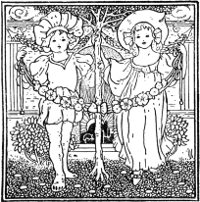
LONDON: T. C. & E. C. JACK, Ltd.
35 PATERNOSTER ROW, E.C.
AND EDINBURGH
PRINTED IN GREAT BRITAIN BY
THOMAS NELSON AND SONS, LTD.
This little book should be used as a simple guide to the practical study of Nature rather than as a mere reader.
Every lesson herein set down has, during the author’s many years’ experience in teaching Nature Study, been taught by observation and practice again and again; and each time with satisfactory result. The materials required for most of the lessons—whether they be obtained from the naturalist-dealer or from the nearest hedge, ditch, or pond—are within everybody’s reach.
There is nothing that appeals to the heart of the ordinary child like living things, be they animal or vegetable, and there is no branch of education at the present day that bears, in the young mind, such excellent fruit as the study of the simple, living things around us.
Your child is nothing if not curious. He wants to understand everything that lives and moves and has its being in his bright little world.
Nature Study involves so many ingenious little deductions, that the reasoning powers are almost constantly employed, and intelligence grows proportionately. The child’s powers of observation are stimulated, and his memory is cultivated in the way most pleasing to his inquiring nature. By dissecting seeds, bulbs, buds, and flowers, his hand is trained, and methods expeditious and exact are inculcated. By drawing his specimens, no matter how roughly or rapidly, his eye is trained more thoroughly than any amount of enforced copying of stiff, uninteresting models of prisms, cones, etc., ever could train it.
The love of flowers and animals is one of the most commendable traits in the disposition of the wondering child, and ought to be encouraged above all others.
It is the author’s fondest and most sanguine hope that the working out of the exercises, of which this booklet is mainly composed, may prove much more of a joy than a task, and that the practical knowledge gained thereby may tempt his little readers to study further the great book of Nature, whose broad pages are ever open to us, and whose silent answers to our manifold questions are never very difficult to read.
T. W. H.
“We are going to have a peep into the inside of these twigs,” said Uncle George, as he laid some willow and horse-chestnut twigs on the table.
“First,” he said, “let us examine the outside of them.” He handed a small willow branch to Tom and a horse-chestnut branch to Frank.
“Now, Frank, tell me all you see.”
“I see the rings of scars which mark each year’s growth,” said Frank. “This year’s growth is at the top, above the first ring of scars. Below this is last year’s growth. Then comes another ring of marks, and below this again is the growth of two years ago.”[1]
“That is to say,” said his uncle, “the upper part of your twig is about one year old, the middle part is two years old, and the lower part is three years old. Go on, Frank.”
“The upper part is light brown, while the middle and lower parts are dark brown.”
“Take your lens, Frank, and look at that brown covering carefully.”
“Oh, it is studded all over with little oval marks like pits,” said Frank.
“Now, what about the buds?”
“The buds,” said Frank, putting down his lens, “are in pairs; and the stem is swollen where each pair of buds comes off.”
“Very good,” said Uncle George. “That is exactly what I wanted you to notice. The swollen parts of a stem are called its nodes. In every stem, buds and leaves occur at the nodes. Nodes are very well seen in grass and corn stems.”
“Then at the top of the twig there is a very large bud and a pair of small buds, one on each side of it,” said Frank.
“You have described it very well,” said his uncle. “Now, Tom, what about the willow twig?”
“I see some very tiny marks on it,” said Tom. “There are no rings marking the year’s growth; and the buds are not arranged in pairs.”
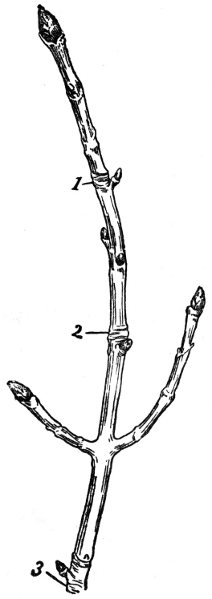
Horse-Chestnut Twig, showing Three Years’ Growth.
“That is quite right, Tom. Willow grows very quickly. Your twig is all one season’s growth. It is smooth and green—not brown like the horse-chestnut twig. The buds are arranged alternately. That is to say, there is only one bud at each node.”
“Now, let us see what the horse-chestnut twig is made of.”
Uncle George next cut two pieces off the top part of the horse-chestnut twig and handed one to each of the boys.
“Now, take your knives,” he said, “and carefully peel off a very small piece of the brown covering. You will have to be very careful, as it is very thin and rather difficult to remove. Ah, Frank, you have done that very nicely. Now, hold it up to the light and tell us what you think it is for.”
“It is the skin or covering of the twig,” said Frank.
“It is; and if you look with your lens you will see that the tiny markings on it are holes. It is really a thin layer of bark or cork. Perhaps you can tell me why the twig is covered with a thin layer of cork?”
“To keep water from getting in,” said Frank.
“Rather to keep water from getting out,” said Uncle George. “You must remember that water is continually passing up stems from the roots. Water cannot pass through cork. If we were to remove the cork layer from the outside of a growing twig, that twig would shrivel up and die. There is also a layer of cork protecting the willow twig, but it is so very thin that we can see through it. Remove as much of the cork layer as you can, and tell me what is underneath.”
“There is a layer of green stuff beneath,” said Frank.
“Just so,” said Uncle George. “Now, if you remember, I once told you that plants took most of their food from the air by means of the green stuff in their leaves. This green layer in the twig does the same thing; but how can the air get in if it is covered up by a layer of cork?”
“Oh, I see now,” said Tom, “what the tiny holes or pits are for—to let air in to the green layer underneath.”
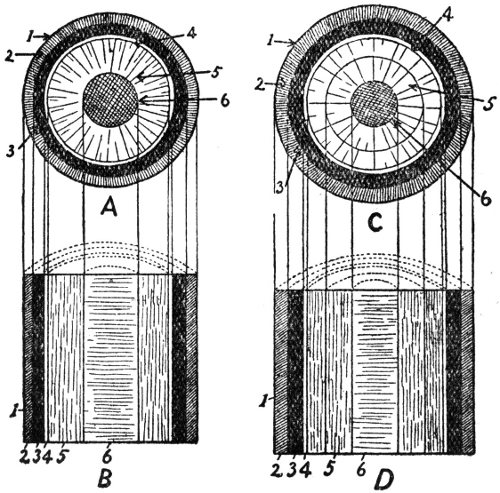
Diagram Sections of (A and B) a One-Year Old and (C and D) Two-Year Old Stem.
“That is what they are for, Tom,” said Uncle George. “Scrape away this green layer. It is greenest on the outside and is rather thick. There are really two or three layers there, but they cannot be separated with a pen-knife. What do you come to next?”
“A white, woody layer with a very slippery surface,” said Frank.
“That slippery surface is itself a layer, and a very important one,” said his uncle. “The wood, you can see, 11 is a very thick layer. In the centre you have a mass of dry, spongy stuff. This is called the pith.”
Uncle George then cut the twig straight across, and the boys saw that each layer formed a ring. In the middle there was a round mass of pith. Around this was a thick ring of wood with the thin slippery layer outside. Outside this was a fairly thick ring, the outer half of which was green in colour. And outside the whole lot was the ring of the thin bark or cork which the boys had first examined.
“We have seen,” said Uncle George, “how a one-year-old stem is built. Let us now make a clean cut through the two-year-old part of the twig, and another through the three-year-old part.
“You see there are two rings of wood in the two-year-old part and three rings of wood in the three-year-old part. What does this show us?”
“That a ring of wood is added every year,” said Frank.
“And so, three years ago, this thick branch was a tiny bud,” said Uncle George, pointing to the lower part of the twig.
“These,” said Uncle George, “are what we grow our snowdrops and crocuses from.”
As he spoke he handed each of the boys a few hard, round objects. Some of these were small, white, and almost pear-shaped. The others were larger, rounder, and brown in colour.
“The small white ones are snowdrop bulbs,” he continued. “The others are crocus corms. There is a great difference between a bulb and a corm, as we shall see when we examine and compare them.”
“The corm is covered with brown, papery skins, and has white buds on the top of it,” said Frank.
“These brown skins are leaves,” remarked Uncle George.
“Leaves?” said Tom. “I thought all leaves were green.”
“Oh no, Tom, there are other leaves besides green leaves, called scale-leaves. Green leaves, as you know, give off the moisture which the roots take up from the soil. They also take in plant-food from the air. Scale-leaves protect buds, flowers, and tender stems from cold and from insects. These thin brown leaves of the crocus corm are scale-leaves formed underground. Please remove the brown scale-leaves from one of the corms, Frank.”
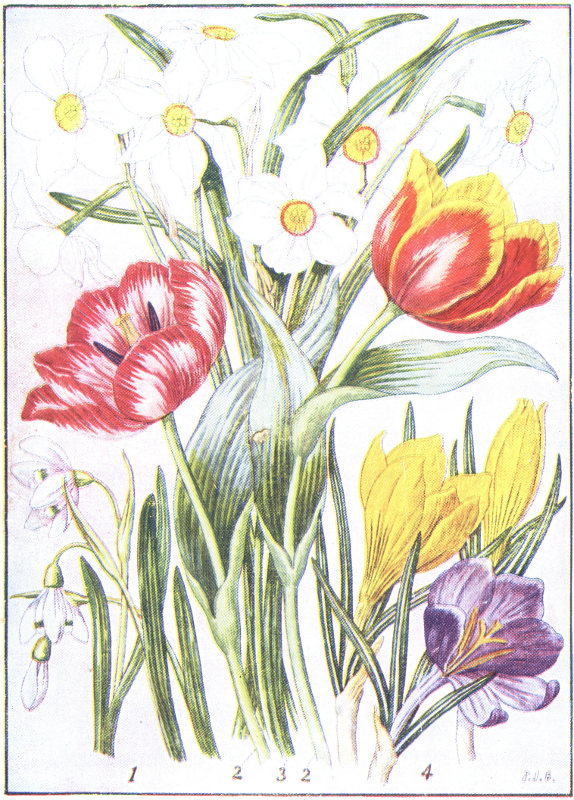
When Frank had done so, it was seen that these leaves were attached in layers all round the corm. The corm was now a white, rounded lump. The removal of the scale-leaves had left thin rings of leaf-marks; and on these leaf-marks, here and there a tiny bud was seen.
“Now,” said Uncle George, “we can see that a corm is a stout, swollen, underground stem. If you could imagine a horse-chestnut stem to be squeezed up into a lump, you would have something like a corm. These rings of leaf-marks are the nodes, where leaves and buds are found on all stems. The large buds on the top of the corm correspond to the large buds at the end of your horse-chestnut stem. Now, let us take off one of these large top buds. Notice that it is covered with many tough, protective scale-leaves.”
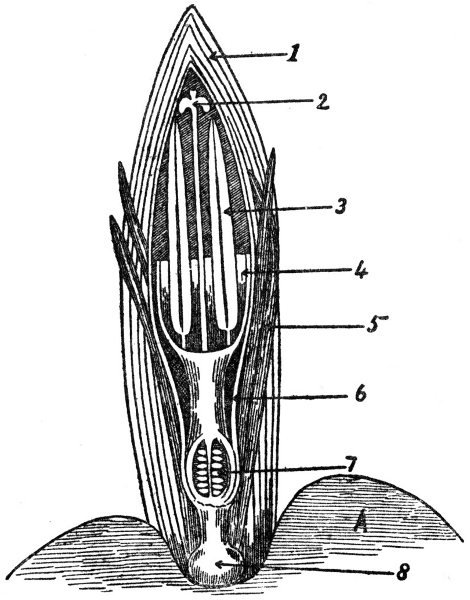
Crocus Bud Dissected.
Removing these scales, Uncle George came to a round object in the centre.
“This,” he said, “is a long sack or bag. It contains the flower of the crocus.”
Taking a needle, he carefully opened this up.
“Now, boys,” he said, “take your magnifiers and look carefully.”
Frank and Tom looked, and saw a curious little 14 flower, surrounded by four or five yellow needle-shaped things which, their uncle told them, were the young green leaves of the crocus.
“Let us now,” he said, “examine the snowdrop bulb.
“Here we have thick, fleshy scale-leaves. If we remove them one by one, we find that they are all attached to a flat, button-shaped stem. Between the thick scale-leaves we see, here and there, a small side bud, and on the top the baby snowdrop flower snugly wrapped up in their sack. This protective sack is called a spathe.”
Uncle George then took from his pocket a very large bulb.
“This,” he said, “is the bulb of the narcissus or ‘white lily.’ It is almost exactly like the snowdrop bulb, but it is larger, so that we can see things much more distinctly.”
He then split the large bulb down the centre with his knife. With a pin he pointed out the baby flower wrapped up in its spathe. All the parts of the flower were seen, even the little seed-vessel containing the tiny eggs, which become seeds after the flower has grown up.
“If you remember,” said Uncle George, “in our lesson on seeds we learned that a seed contained a baby plant and a large supply of plant-food. I am now going to show you that both the corm and the bulb contain a large food supply. We have seen that the protective bud-scales in the corm are tough and thin, while the stem is swollen and hard. In the bulb, on the other hand, the bud-scales are thick and fleshy, while the stem is flat and very small. If we place some of our crocus corms 15 or snowdrop bulbs in pure water, they will grow and flower just as well as if we had planted them in the garden. What does this show us?”
“That, like the seeds which we grew in water, bulbs and corms contain a store of food,” said Frank.
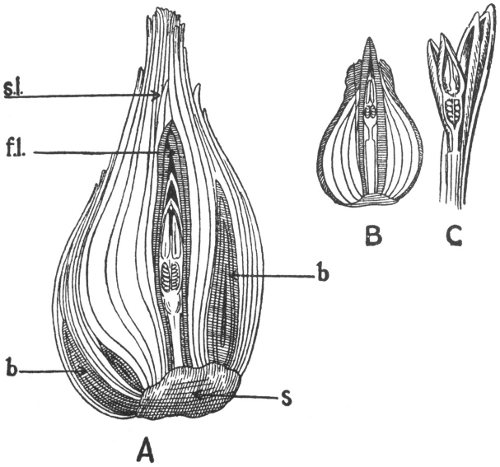
“That is correct, Frank. Let us put a corm and a bulb in water. Let us also plant one of each in a pot of soil. We will watch them growing and compare them from week to week.
“Now I am going to show you a simple experiment. You know that the food we eat is drawn largely from plants. This food which we take from the plant world 16 is chiefly what the chemist calls starch. We have it in bread, potatoes, rice, cornflour, and in nearly all the vegetables we eat.
“I have here in this bottle a substance, called iodine, dissolved in water. Anything containing starch turns blue when touched with iodine. Now observe what happens here.”
Uncle George poured some of the iodine into a saucer. He then dipped into the iodine a piece of crocus corm, a thick scale of the snowdrop bulb, soaked seeds of maize and wheat, a slice of raw potato, and a piece of bread. Each at once turned dark blue on being dipped into the liquid.
“Now, boys,” he said, “what do you learn from this?”
“The food store in bulbs and corms is the same as that in seeds,” said Tom.
“The food supply of the bulb is contained in the thick, fleshy scale-leaves, while in the corm it is in the stem,” said Frank.
“Very good,” said Uncle George. “It also shows us, I think, that we ourselves owe a great deal to the plant world.”
“We have seen how an ordinary twig is built up,” said Uncle George. “Let us now try to find out what goes on inside the twig; and in order to do this we shall have to perform one or two simple experiments.”
Uncle George took two wide-mouthed glass jars. They were both perfectly dry, and each could be closed with a large, tight-fitting cork. He placed some fresh green leaves inside one of the jars. The other remained empty. Then both jars were tightly corked up, and both corks covered outside with wax.
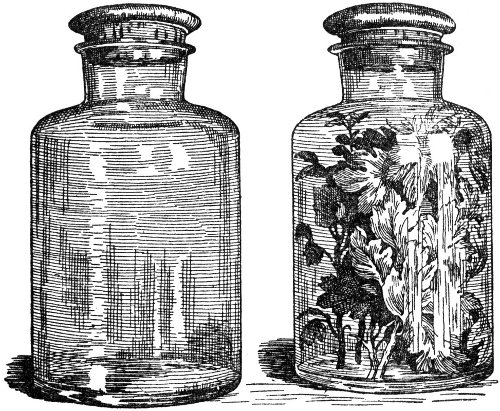
First Experiment.
“That is experiment number one,” he said, as he placed both jars in the window.
He next took a small plant which was growing in a pot. He wrapped the pot up in thick, dry paper, so that the paper covered up everything but the plant. The edges of the paper were tied tightly round the lower part of the stem of the plant with a string. The plant was put in the window, and over it Uncle George placed a glass bell-jar.
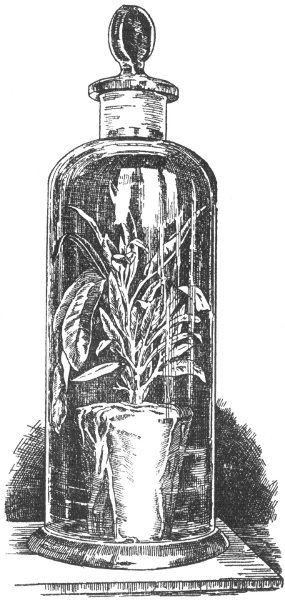
Second Experiment.
“The third experiment is much simpler,” he said. “You see I just put one of the willow twigs into a glass half filled with water, and into the water I pour some red ink. Frank, place a white pansy in the coloured water beside the willow twig.”
Uncle George’s fourth experiment was as follows:—
He placed four willow twigs in a glass of water. But from two of these twigs he first removed a broad ring of the bark and outer layers, leaving about an inch of the wood bare near the lower end of the twig.
“Now,” said he, “we will come back in about an 19 hour, and I think we shall find that some change has taken place in each of our first three jars.
“The fourth glass one will have to be left for several weeks; and we must take care to keep water always in the glass containing these four twigs.”
About an hour afterwards, Uncle George and the boys came to look at the experiments.
“Let us examine experiment one first,” said Uncle George.
“The empty jar is just the same as when we put it there,” said Tom. “The jar containing the leaves is all dimmed, and there are tiny drops of water on the inside of it.”
“Where did that water come from, Tom?”
“It must have come out of the leaves.”
“Exactly so! Now look at the second experiment, and you will see that the bell-jar which covered both plant and pot is also dimmed with moisture. Pot and soil were securely covered up, so that this moisture on the glass must have come from the leaves of the plant. Where do you think this water really comes from?”
“From the soil in the pot,” said Frank. “If we did not water those plants which we keep in pots, they would die.”
“Then we have learnt that water travels up the stems of plants,” said Uncle George, “also that it is drawn from the soil and is given off by the leaves. The third experiment, where we placed a twig in coloured water, will, I think, show us which part of the stem the water travels up.”
Uncle George peeled the bark off the lower end of the willow twig which was placed in the mixture of red ink 20 and water. He removed all the layers until he came to the wood. The wood was stained red. He cut slice after slice off the twig, and it was found that the coloured water had gone quite an inch up through the wood. None of the other layers of the twig were stained red.
“It travels up through the wood-layer,” said Frank. “And look at the pansy flower. It was white when we put it into the glass, now it is all streaked with red.”
“The flower itself,” said Uncle George, “is not near the coloured water.”
“The water must have travelled up the long stalk to the flower,” said Frank.
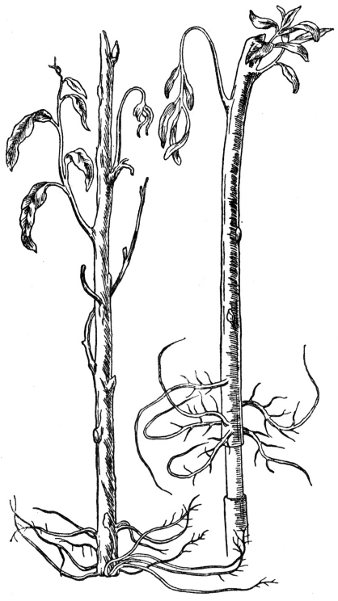
The Fourth Experiment.
The fourth experiment was left in the window, and two or three weeks passed before any change was noticed in any of the four twigs which had been placed in the water. Then roots began to grow. In the two whole twigs these roots grew out at the bottom end. But in those twigs from which the belt of outer layers had been removed, it was quite different. Here the roots grew out—not at 21 the bottom, but just where the ring of bare wood began and at the top of it.
Frank and Tom were quite puzzled. They could not understand why the roots should come at the bottom in two of the twigs and not in the other two.
“First of all, then,” said Uncle George, “these new roots were made from materials which came from inside the plant. These building materials are carried through the plant dissolved in water—just as you dissolve sugar in your tea. Water containing these dissolved stuffs in a plant is called sap.
“We have seen, by our first three experiments, that water travels up the wood part of the stem. This experiment shows us that sap travels down the stem in the layers outside the wood. For, when I removed the outer layers and left a bare ring of wood, the flow of the sap was stopped and the new roots formed there.”
“And where does this sap come from first of all?” Tom asked.
“It is really formed in the leaf first of all. I think I told you that plants take most of their food from the air by means of their green leaves. In the great quantities of water which pass up the wood and into the air from the leaves there is always a very little mineral matter dissolved. This small quantity of mineral matter comes from the soil. This, along with water and the large quantity of matter taken from the air, are changed, inside the leaf, into a fluid which we call sap.
“Our four experiments show us that water travels up through the wood-layer from soil to leaf; and also that 22 sap travels down through one of the outside layers of the stem.”
The boys watched the growth of the crocuses in water and in soil from day to day, and made sketches of them once a week. Fed by the food contained in the corm, the top buds of the crocus grew longer. Then the scales moved apart and the yellow flower was seen. Round about it were four or five narrow green leaves, each having a pretty white stripe down the middle. Both leaves and flower were encircled at the base by long white sheaths.
The crocus grown in the pot did not seem to thrive much better than the one in the water. Both flowers remained closed for a long time after they were full grown.
At last, on one fine sunny day, they opened out wide at the top, and the boys could see right down into them. In the evening they closed up again. Next day was a dull day, and the crocus flowers remained closed.
The snowdrops were also watched and sketched. Their growth was somewhat different. From the centre of the little bulb two green leaves first appeared. These leaves were much broader and thicker than those of the crocus. From between these leaves a little white, flat object grew up. This the boys at once recognised as the spathe or bag containing the flower. Then more green leaves came up. The flower-stalk grew longer. The spathe split open, and the flower-bud appeared.
This bud grew until it became a beautiful white bell hanging downwards.
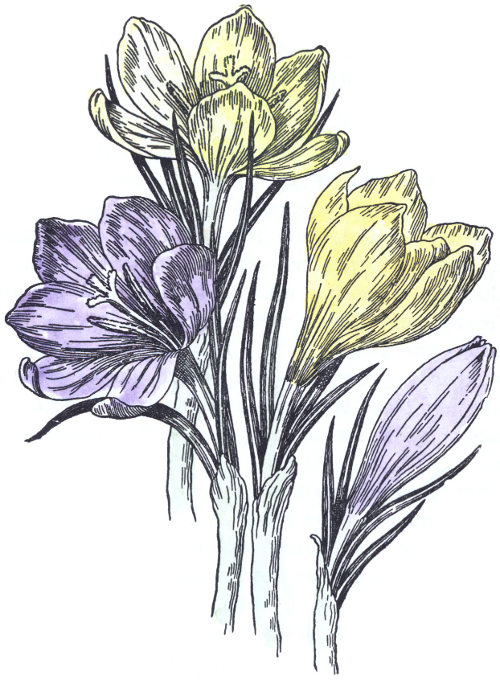
Crocus Flowers.
In a large pot Uncle George had planted a few tulip bulbs. They were not completely covered with soil, so that their growth could be watched. Their growth was similar to that of the snowdrop. The leaves came first. 25 They were rolled firmly round each other. As each large, broad, green leaf unrolled, another rolled-up leaf was seen under it. These leaves were rolled round a thick stalk, to which they were attached. When the last leaf unrolled, a single flower was seen at the top of the stalk. This flower remained closed up like the crocus. When at length, however, the warm sun shone in the window, the tulip flowers opened out very wide indeed; in fact, they became almost saucer-shaped.
Then Uncle George dug the snowdrop and crocus out of their pots. He washed the roots and asked the boys to compare them with those grown in water.
“The plants grown in soil seem stronger in flower and leaves,” said Frank. “But the greatest difference is in the corm and bulb.”
“That is right, Frank,” said Uncle George. “Look at the crocus corms. They have both shrunk a great deal, because they have been used up to form what has grown out of them. But the one grown in soil has formed a new corm, which will produce new flowers next year. This new corm has grown upon the top of the old one. The crocus grown in water has also produced a new corm, but it is too small to produce a flower next year.
“Then, again, take the snowdrop. The one grown in the soil has produced two or three new bulbs, while that grown in water has not. These new bulbs were the side buds we noticed between the scales when we opened out our snowdrop bulb. In both snowdrops the old bulb has been completely used up to form green leaves and flower.
“But the bulb grown in soil has not only produced 26 flowers and green leaves. It has gathered up enough material from soil and air to form new bulbs for next year.”
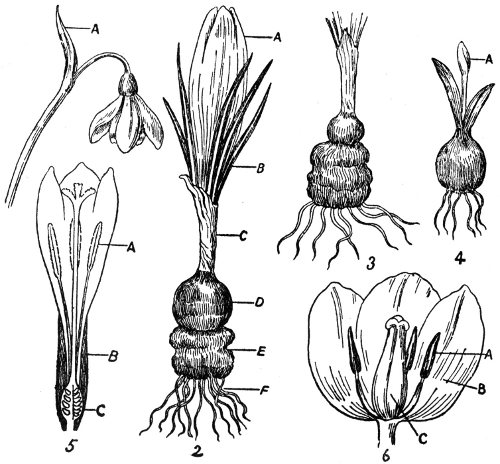
Uncle George then divided the crocus flower with his knife from top to bottom.
“At the very bottom of the flower,” he said, “you see the ovary, or seed-vessel, containing the tiny seeds. From the seed-vessel a long thin rod or tube stretches 27 to the very mouth of the flower. You can also see the remains of the spathe which once enclosed the whole flower.”
“And what are those three things covered with orange-coloured dust?” asked Tom.
“These,” said his uncle, “are the stamens or pollen-boxes; and the orange-coloured powder is the pollen. This pollen is carried about from flower to flower by the bees. Pollen is necessary for the production of seeds.
“Do you know why the seed-vessel of the crocus is so far down under the ground?
“It is because the crocus flowers in winter-time, and the frost might kill the young seeds. Underground they are safe from frost. The snowdrop is a hardy flower, and, besides, the walls of its seed-vessel are very thick.
“The tulip, if grown outside, flowers much later than the other two plants.
“Notice the difference between the flower of the tulip and those of either crocus or snowdrop. Its petals are all separate, while those of the others are joined to form a bell or tube. The seed-vessel of the tulip, also, stands right up in the centre of the flower, while that of the snowdrop (and crocus) is placed underneath the flower altogether.”
“How is it, Uncle George, that the flowers of both tulip and crocus open out wide when the sun shines and close when the sun goes down?” asked Frank.
“Plants can feel to a certain extent,” said Uncle George. “That is to say, they are affected by heat and cold, by light and shade. A great many flowers close up at night—the daisy, for instance; and have you never 28 noticed how clover leaves fold up long before night comes?”
“Yes, but why should the crocus and tulip open and close? The snowdrop never closes up.”
“They do so to protect their pollen,” his uncle answered. “Rain or dew would ruin pollen. Those flowers, like the crocus and tulip, which open out to the sky must close up, or the precious pollen would be destroyed. Flowers like the snowdrop and bluebell, which hang downwards, have no need to close up, for their pollen is under a roof of joined petals.”
When the sweet-peas in the garden were nearly full grown, Uncle George sowed some sweet-peas in a pot. In a fortnight those sown in the pot were about four inches in height, and those in the garden were in flower.
“Let us go into the garden, boys,” he said, “and see if we can learn something from the sweet-pea.”
In the garden the sweet-peas were really lovely. They looked, as Frank said, like so many beautiful butterflies on the wing; and they filled the air with delicious perfume.
“I think,” said Frank, “that our row of sweet-peas is by far the best thing in the garden.”
“That is quite true, Frank,” said his uncle, “but it is not so much the flowers we are going to study at present. The sweet-pea is certainly one of our finest flowering plants. It is also one of the most interesting. Can you tell me why we put stakes up for our sweet-pea plants to cling to?”
“Because they have long, slender stems—too slender and weak to grow up by themselves,” said Frank.
“Quite right, Frank. If the sweet-pea were a wild plant, where would it grow?”
“In the hedges,” said Tom.
“Right again,” said Uncle George. “If we grow the sweet-pea in the garden, we must imitate its surroundings in the wild state—we must give it a hedge of some kind to cling to, otherwise it would trail along the ground.”
“Then it would get choked among the other plants,” said Frank.
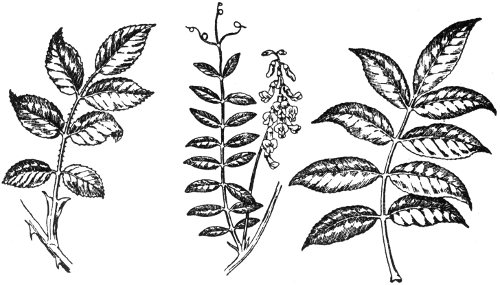
“What do you mean by ‘choked,’ Frank?”
“Well, it would die for want of air”——
“And light,” his uncle added. “No green plant can live without air and sunlight; and, in order to get these, our weak-stemmed sweet-pea has to climb. It clings to its stronger brethren just as the wild peas do in the hedgerow. Now notice how it climbs. The end part of each leaf consists of little gripping organs called tendrils. These twine tightly round the smallest twigs near them.
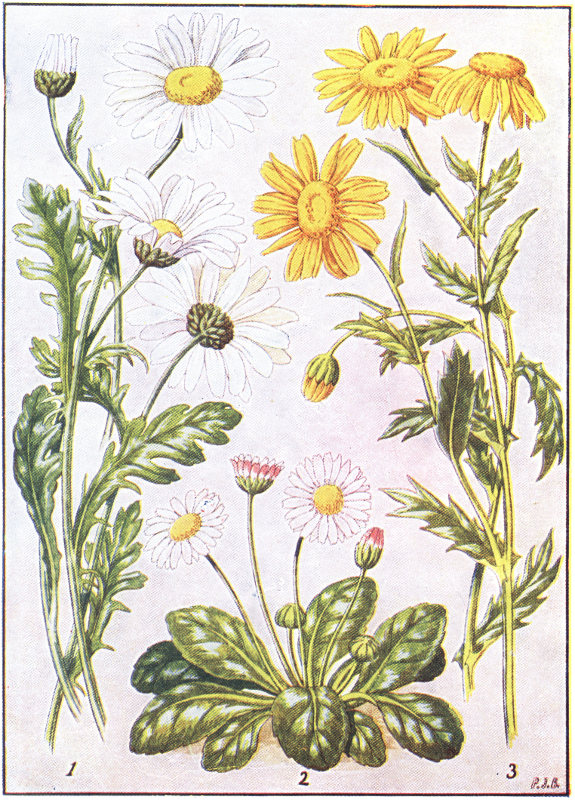
“Here is a rose leaf. It is composed of several leaflets, and at its base there are two small, brownish-green things called stipules. If we compare this leaf with the leaf of the sweet-pea, we find that in some points they are similar, but in others very different.
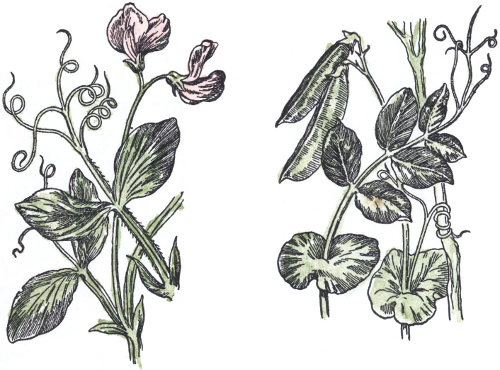
“The rose leaf is called a compound leaf, because it is made up of many small leaflets. The sweet-pea leaf is also a compound leaf, but it has only two leaflets, and these are of enormous size. The rose leaf has two small stipules. The stipules of the sweet-pea leaf are large and green.
“If I place the rose leaf beside a sweet-pea leaf, you will notice that the latter has no upper leaflets.”
“It has tendrils ‘instead,’” said Frank.
“Exactly!” said Uncle George. “These tendrils 32 correspond to leaflets. Now, if the plant has been forced to turn all its leaflets, except two, into gripping organs, how does it manage to make up for this loss of green leaves?
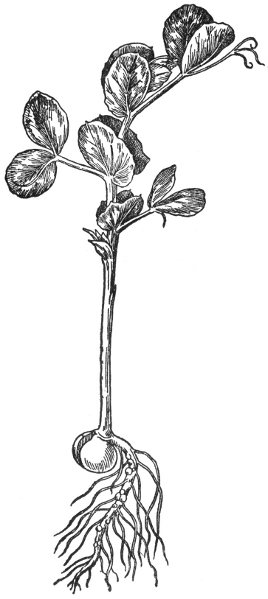
Young Edible Pea.
“We have already learned that plants take in food from the air by means of the green substance in their leaves. The more of this green substance a plant possesses, the more food it can take in from the air. If it sacrifices leaves in order to climb up to the light and air, its amount of the green material must be lessened. But the sweet-pea makes up for this loss of leaves. Can you see how it does so?”
“The stipules are very large,” said Frank.
“And the lower part of the leaf-stalk is very flat, broad, and green,” added Tom.
“Very good,” said Uncle George, “but look at the long, slender stem. It has flat, green, ribbon-like outgrowths on each side throughout its whole length. So, you see, what the plant loses in leaves, it makes up in another way.
“Let us now look at the ordinary pea plant. Its leaf has four pairs of leaflets and three pairs of tendrils 33 besides the terminal tendril—seven tendrils altogether. The stipules here are also very large—much larger than those of the sweet-pea. But the stem is round and smooth. There are no green outgrowths. Here is a wild pea, which I found to-day, which has no leaves at all. All its leaflets have been turned into tendrils or gripping organs. But look at the enormous stipules it has! They are much bigger than ordinary pea leaves.
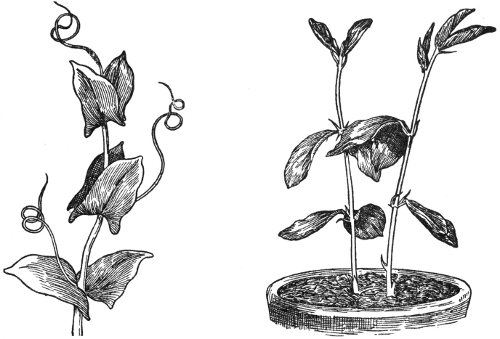
“Let us now look at the tendrils of the sweet-pea, and see how they grip their supports. Notice that they begin to twist long before they reach the supporting twig. Then, when they have reached it, they twist round it in the opposite way—just like a piece of string, if you twist it at one end, it untwists at the other.”
“Can you see any reason for this coiling before it 34 reaches the twig?” As he spoke, Uncle George pulled a sweet-pea plant out from its supports, and the boys saw that the tendril was really a spiral spring. The plant could be pulled out a considerable length without breaking the tendril.
“You see,” Uncle George continued, “if it were not for that first coiling of the tendril—that is to say, if the tendril grew out straight and only began to twist when it reached the twig—the first breeze of wind would snap the plant from its supports and it would fall to the ground.
“Look now, at the young sweet-peas which we grew in the pot. They are without tendrils of any kind. This shows us, I think, that the sweet-pea was at one time a small plant, like its relative the clover. It grew in open places and did not have to struggle for light and air. But, by and by, when strong growing plants took up the soil, it became forced to produce climbing organs or become choked out. And, having turned its leaves into climbing or gripping organs, it made up for the loss of leaves by producing large stipules and green out-growths to stem and leaf.”
During summer the boys paid many visits to the horse pond. Each time they went there they saw something to interest them.
Their uncle taught them to keep perfectly still while looking into the water. They soon came to know that this was the best way to study pond-life, for, whenever they moved, the creatures they were watching would dart out of sight.
One day, while they were both lying on the bank gazing into the pond, a huge black beetle came up to the surface of the water. It remained there for a few moments, with its head hanging downwards and its tail sticking right out of the water. Then it dived down out of sight. In a few minutes it came up again, and this time Frank’s net was under it before it could escape.
Just as Frank was putting it into the glass jar, Tom whispered, “Here is another one—quick, Frank!”
But Frank was too late; for before he could get the first beetle into the jar, the second one had dived to the bottom of the pond. The boys waited for a long time, hoping to see the other beetle again. At last their patience was rewarded. The beetle came up again to the surface. As soon as it did so, in went the net, and out came beetle number two.
“What big beauties,” said Frank. “I wonder what they are. Let us hurry home and show them to Uncle George.”
When they got home, their uncle placed the two beetles in a glass tank by themselves, so that they could be more easily observed.
“What do you call them, uncle?” asked Frank. “We have never seen such large, handsome beetles before.”

Dyticus Beetle, male and female.
“Have you not?” his uncle replied. “I am surprised at that, for this beetle is found in nearly all our ponds and ditches. It has a long Latin name,[2] which means Bordered Diver, but it is commonly known as the ‘great water beetle.’ There are several kinds of these diving beetles. This is the largest. Can you give me an idea of their size?”
And Uncle George handed Frank a small measuring rule which he carried in his pocket.
Frank looked at the beetles, and then moved his thumb nail along the rule.
“About an inch and a half in length,” he said.
“That is about right,” said his uncle. “Are these two beetles exactly alike?”
“They are both about the same shape and colour. One is slightly bigger than the other. They are both greenish-black above and brown below. There is a curious broad border of yellow all round the edge of their bodies,” said Tom.
“But they are not both exactly alike,” said Frank, “I notice that one is smooth on the back, while the other’s back is all grooved.”
“You are right, Frank,” said Uncle George. “The one with the grooved wing-cases is the female. The one with the smooth cases is the male.

Fore Leg of Male, showing Sucker Organ.
“Notice the long legs they have for swimming, and how they seem to oar themselves through the water. Notice also that the male has a large flat disc upon each of his fore legs. These are suckers, by which he can cling to things.”
“Why do they come up to the surface so often?” Frank asked.
“They cannot live without air. They carry a supply of air under their wing-cases. They just come up to renew it from time to time. This is done by thrusting the end of their bodies out of the water as you see.”
“One would think they ought to thrust their heads out to get air,” said Tom.
“That seems more natural to us, because we breathe with our mouths,” said Uncle George. “These animals take in air with their tails. A great many pond insects breathe in this curious way.”
“What do they feed upon?” Frank asked.
“They are fierce, greedy creatures,” his uncle replied. “They attack and kill worms, tadpoles, and even small fishes.”
Uncle George threw a small worm into the tank. One of the beetles seized it at once and began to devour it greedily. Presently the other beetle seized an end of the worm. The boys watched closely, and saw that the beetles’ jaws moved from side to side like a pair of pincers.
Next morning, when Uncle George and the boys went in to see the beetles, they found only one in the tank. The other had escaped during the night. After a careful search they found it, at the far end of the room, dead.
“Now, how do you think this beetle managed to get out of the tank and travel all that way?” Uncle George asked.
“It must have crawled up the inside of the tank, then down the outside. Then it must have fallen off the window-sill, and crawled right across the floor,” said Frank.
Uncle George shook his head.
“It might,” he said, “have managed to crawl up to the edge of the tank so long as its legs were wet. But as its long legs are made for swimming, and not for crawling with, I can hardly see how it could have crawled or walked all that distance.”
“Then how did it get there, Uncle George?”
In answer to Frank’s question, his uncle took the dead beetle, and placed it on a piece of paper on the table. He next moved aside each of the large black wing-cases with a pin.
Underneath these wing-cases the boys saw a pair of large wings neatly folded up. Uncle George removed one of the wing-cases, and unfolded one of the wings. 39 Stretched out, it was longer than the beetle’s body, and it seemed to be made up of thin, clear skin, stretched on a framework of long, thin supports.
“Why, these beetles can fly,” said Tom.
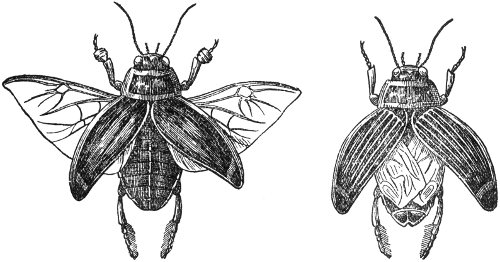
Male and Female Beetles, showing Flying Wings.
“Of course they can,” said his uncle. “All beetles can fly. This creature has evidently been flying about the room all night. These insects are furnished with wings, so that they may be able to fly to another pool when food gets scarce, or when their pool dries up.”
While Uncle George and Frank and Tom were having a game of cricket, Dolly was amusing herself in another way. She had pulled a bunch of daisies and was joining them up into a daisy chain.
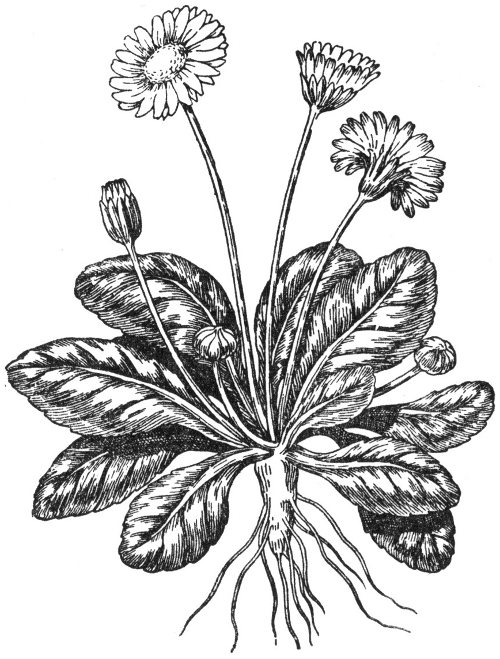
Common Daisy.
She finished her daisy chain just as her uncle and the boys finished their game.
“We will take some daisies home,” said Uncle George. He stooped down and dug out a whole daisy plant with 41 his knife, while Dolly gathered a small bunch of the flowers. When they got home Uncle George placed his daisy plant in a saucer of water, and told the boys to bring out their magnifiers and sketch-books.
“First of all,” he said, “I want you to look at the daisy plant. Notice its leaves. Each leaf is broad at the end and narrow where it joins the plant. Notice also that the leaves all form a round green mat on the ground. Now, can you tell me what the leaf resembles in shape.”
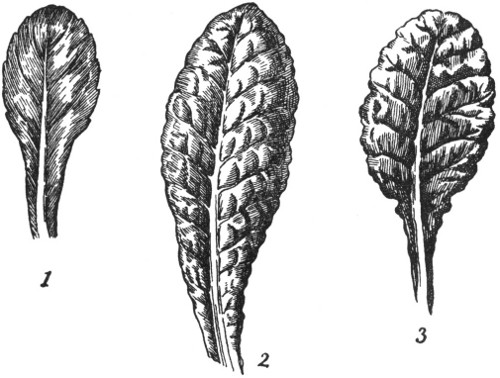
“It is like a spoon,” said Tom. “It is,” said his uncle; “and can you see any reason for it being so shaped?
“You cannot? Well, I must tell you. All plants whose leaves are all at the ground have leaves shaped something like this. The primrose and cowslip are good examples. We have seen that plants, like the pea, climb up so that their leaves and green parts may 42 get as much light and air as possible. And if you look at any tree, such as the horse-chestnut, ash, elm, or beech, you will notice that their leaves are spread out so as to catch as much light as possible.”
Uncle George then drew a circle.
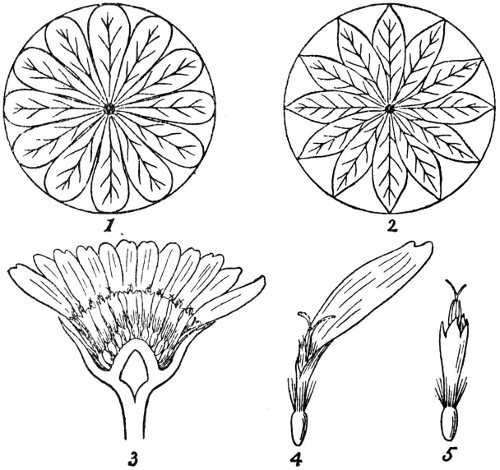
“Now, boys,” he said, “I want you to try to fill that circle with leaves so shaped that they will fill it without covering one another. The best way to do so is to make them broad at the end. If you make them broad at the base and narrow at the end, they overlap and rob each other of light and air. Now you can see why the leaves of the daisy are so shaped.
“Take up a daisy and split it down the centre with 43 your knife. You will notice that the daisy is not a flower, but a collection of tiny flowers, or florets, all packed closely together upon a pad or disc, and surrounded outside by many little green things like small leaves. These little leaf-like things are called bracts.”
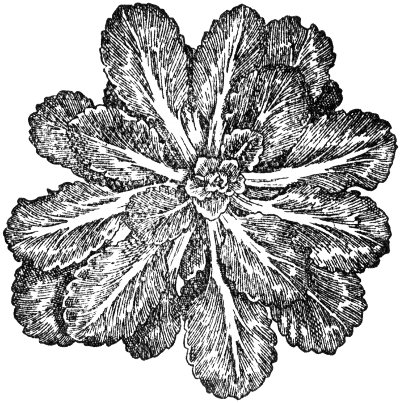
London Pride, showing Leaf arrangement.
“There are two distinct kinds of florets,” said Frank, looking at the split daisy with his lens.
“Yes,” said Uncle George, “you will see them better if you remove one of each with a pin, and examine them separately.”
“The outer florets are very large and white,” said Frank.
“They are very flat, while the inner ones are yellow and round. They are very like small crocus flowers. What is that small two-headed thing that comes out in the centre of each floret?”
“That is the part which leads to the seed-vessel. Can you see the seed-vessel at the bottom of each floret?”
“Yes,” said Tom, “it is large and round. On the top of it and all round the petal part of the floret there are long silky hairs.”
“In flowers of this kind, when the seeds are ripe they are carried away by the wind,” said Uncle George. “The petal part withers, but the tuft of hairs remain. They are to the seed what sails are to a ship. They are 44 much better seen in some other flowers related to the daisy, such as the thistle.
“Now cut open the seed-vessel and see how many seeds it contains.”
“There is only one, I think,” said Frank.
“You think correctly,” said his uncle. “Each seed-vessel holds a single seed.”
“The seed-vessel in the large white floret is small and flat,” said Tom.
“It is,” said Uncle George. “In fact, the outer florets seldom produce seeds.”
“Then what is the use of them?” Tom asked.
“I’ll show you,” said Uncle George. As he spoke he took up a fresh daisy flower.
“Look!” he said, “what a pretty flower it is, with its golden centre and its bright white edge tipped with red. It is like a beautiful star.”
Then he pulled off all the large white florets.
“Look at it now,” he said. “It is a dingy, ugly little flower. Without its white florets it would not be seen at all. Now perhaps you can tell me what the large white florets are for.”
“To help us to see them at a distance,” said Frank.
“So that bees and other flying insects may be able to see them,” said Uncle George.
“Insects visit flowers for honey, and, in doing so, carry the yellow dust, or pollen, from flower to flower. This pollen, as I told you before, has to do with the making of seeds: and stronger seeds are produced if the pollen comes from another flower.
“Now compare a white floret with a yellow one, 45 and you will notice still another difference between them.
“Round the stigma—that is the forked tube which leads to the seed-vessel—in the yellow florets, there is a yellow ring of stamens, or pollen-boxes. It is shaped like a little barrel with its ends knocked out, and the stigma grows right up through it.
“In the white florets there are no pollen-boxes of any kind.
“Thus, we see that the inner florets are perfect florets which produce seeds.
“The outer florets have all run to petal. Their business is to show the way to the plain little florets in the middle.
“There is another thing about the daisy that I should like you to notice,” Uncle George continued. “If you go out on a dull day, or in the evening, you will find all the daisy flowers closed up. They only open out in bright sunshine, when all the insects are flying about.”
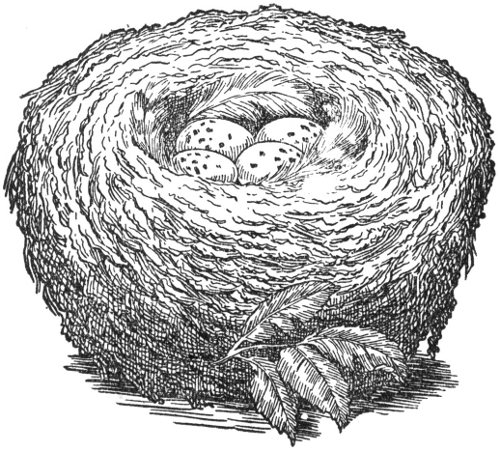
Nest of Chaffinch.
It was Frank who found the chaffinch’s nest in the wood. It was built in the fork of a small tree, about eight feet from the ground.
Although not surrounded either by branches or leaves, it was completely hidden, for the cunning little birds had matched the outside of the nest exactly with the bark of the tree.
Uncle George got an old chaffinch’s nest from the gardener, and showed the boys how it was constructed. Horse-hair, feathers, and moss were neatly woven together to form the nest. The inside was lined with finer hairs and feathers. The outside was covered with pieces of bark, lichen, and faded moss. These were stuck on with silken threads stolen from spider’s webs. The whole thing looked at a distance more like a part of the tree than a bird’s nest.
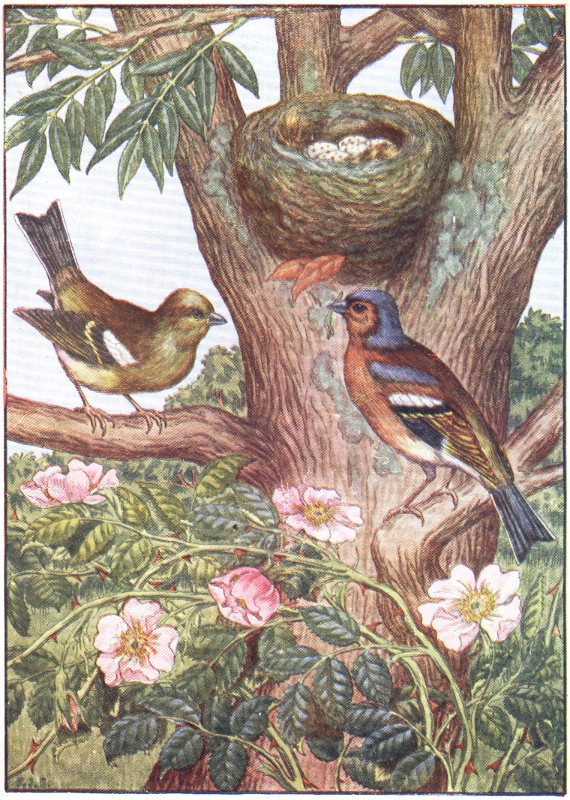
A CHAFFINCH’S NEST
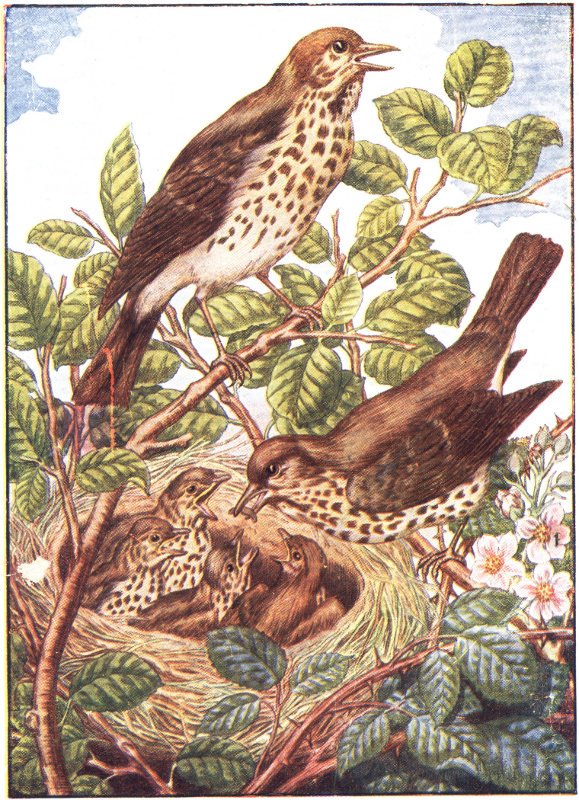
THE THRUSH
The next time the boys went to see the nest they found four tiny eggs in it. They were bluish-green in colour, and splashed with red and brown marks.
It was while paying a third visit to the chaffinch’s nest that Uncle George found the nest of the song-thrush.
High up on a tall tree the cock thrush was pouring out his song, and filling the woods with melody.
“Can you see him, boys?” Uncle George asked, and he handed Frank a pair of field-glasses which he used for watching the birds.
“Oh, yes,” said Frank, “I can see him quite plainly. He is a brown bird, with a white and yellow breast, all dotted over with small dark spots.”
“He is not such a beautiful bird as the chaffinch,” said Uncle George, “but he is a much finer singer. Our prettiest birds are by no means our best songsters. The lark, thrush, linnet, and nightingale are all plain birds to look at, but they are by far our sweetest singers.”
“Tell us what you see through the glasses, Tom?”
“I can see him nicely,” said Tom. “He holds his head high in the air, as if he were singing to the sky. His bill is wide open, and the feathers of his throat are moving rapidly as he sings.”
“I think,” said Uncle George, “that his nest must be near. Let us look for it.”
Just as Uncle George moved, a brown bird flew out of a low bush close at hand.
“Ah, ha!” said Uncle George, “I thought we should find it. We have disturbed the hen bird. She has been sitting on her eggs all the time.”
He moved the branches of the bush gently aside, and the boys saw a large nest made of dried grass. It was not very high up, and the boys, by standing on an old tree stump, could look down into it.
“Oh, what pretty eggs,” said Tom. “There are four of them, Uncle George. They are light blue in colour, and sprinkled with black spots.
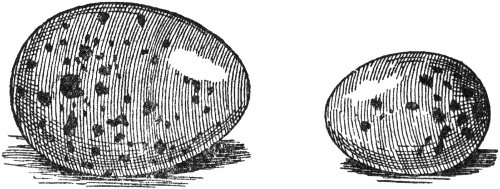
“The nest is quite smooth and hard inside. What is that queer brown stuff all over the inside of the nest?”
“That is clay, Tom. When the thrushes have built their nest, they line the inside of it with clay. This clay is soft at first, but it soon dries and turns quite hard.
“But, come, let us go, boys. The cock thrush has stopped his singing. He and his little wife are flying about in great alarm.”
When they came to the chaffinch’s neat little nest in the fork of the tree, they got a great surprise. The four little mottled eggs were gone. In their place were four tiny naked creatures, with little tufts of dark coloured down upon their heads and necks. They had very large mouths, and their eyes were closed.
“Oh, what funny little things,” said Frank.
As soon as he spoke, the baby chaffinches stretched out their slender little necks, opened their wide, gaping mouths, and cried for food.
“Pink, Pink, Pink!” came from a neighbouring tree.
“Come down, Frank!” Uncle George whispered. “Let us go back from the nest, and we will perhaps see the old birds feeding them.”
With another “Pink, Pink, Pink,” the cock chaffinch flew down and stood on the edge of the nest. He had something in his bill. This he dropped into one of the gaping little mouths, and flew away.
Next came the hen bird with something in her bill. She fed another of the hungry little birds, and flew away also.
The boys were greatly interested. They wanted to stay the whole afternoon and watch the chaffinches feeding their young, but their uncle would not allow this.
“No, no, my dear boys,” he said, “we must not annoy our little feathered friends too much, or they may forsake their beautiful nest and their helpless young ones.
“We will come back in a fortnight and see the young birds. You will not know them then, for they will be fully fledged.”
“What do you mean by ‘fully fledged,’ Uncle George?” Tom asked.
“It means covered all over with feathers, does it not?” said Frank.
Their uncle nodded.
“Are these little birds not cold without feathers?” asked Tom.
“Oh, dear, no,” his uncle answered. “During the 50 day they cuddle up together in their cosy nest. At night the mother bird folds her wings over the nest.”
“Where does the cock bird go at night?” asked Tom.
“He sleeps on a branch quite near the nest,” his uncle answered.
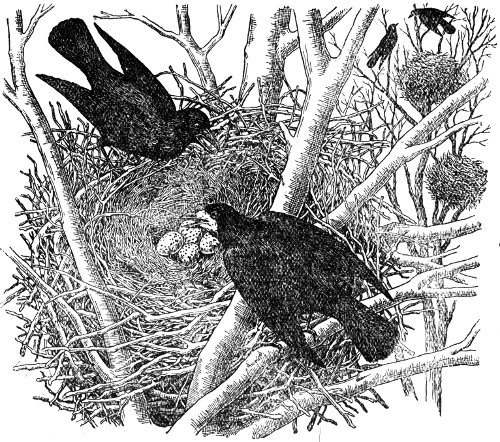
Rooks and Nest.
“I have just two more questions to ask, Uncle George,” said Frank. “What do the chaffinches feed their young ones on? and what becomes of the young birds after they are fledged?”
“They feed their young chiefly on small worms, flies, 51 grubs, beetles, and other insects. When the young chaffinches are fledged, their parents lead them from the nest. They teach them to fly, and show them where to find their food. They never lose sight of them until they are quite grown up and able to take care of themselves.”
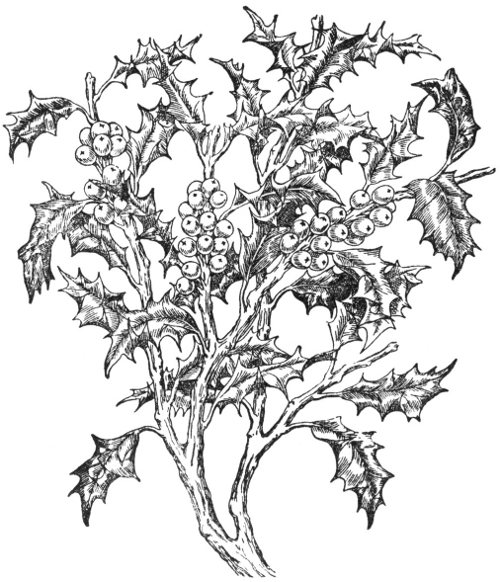
Holly branch.
“Some time ago,” said Uncle George, “I promised to tell you something about how plants arm themselves. And here, in this hedgerow, we have some good examples of armed plants.”
“There is the stinging nettle,” said Tom, pointing to a large patch at the roadside.
“The stinging nettle is certainly well protected,” said his uncle. “You have only to touch any part of it lightly with your hand to find that out. Every part of the plant is covered with small needle-shaped hairs. 53 These hairs are hollow and contain a poisonous juice. At the base of each hair there is a bag filled with this juice, while the tip of each is sharp and very brittle.
“When your hand touches a nettle—unless you grasp it tightly—the sharp hair pierces the skin. It’s brittle point breaks off and the poisonous juice is poured out.”
“Why is the nettle covered with these horrid stings?” asked Frank.
“To save it from being eaten up, of course. The nettle is a tender and juicy plant, and, if it were not for its stings it would soon disappear altogether.
“Now, here is another armed plant, the blackberry or bramble. The stem and also the backs of the leaves are covered with large curved prickles. These prickles not only protect the plant from grazing animals, but they help it to climb and scramble up walls and hedges.
“If you try to pull a bramble branch down out of the hawthorn hedge, you will find it rather difficult, for its large prickles are all turned one way. They are really sharp hooks.”
“Here is a wild rose bush. It is also covered with large hooked prickles,” said Frank.
“Yes, Tom, and, like the bramble, it threads its way among stronger and taller plants.
“The wild gooseberry growing close beside it is also armed with prickles. But the prickles of the gooseberry are for protecting its tender leaves. It is not a climbing plant like the rose and bramble. The raspberry also is covered with many sharp little prickles. There is a clump of these plants growing at the other side of the road. Let us cut off a small branch of each of these plants and take them home.”
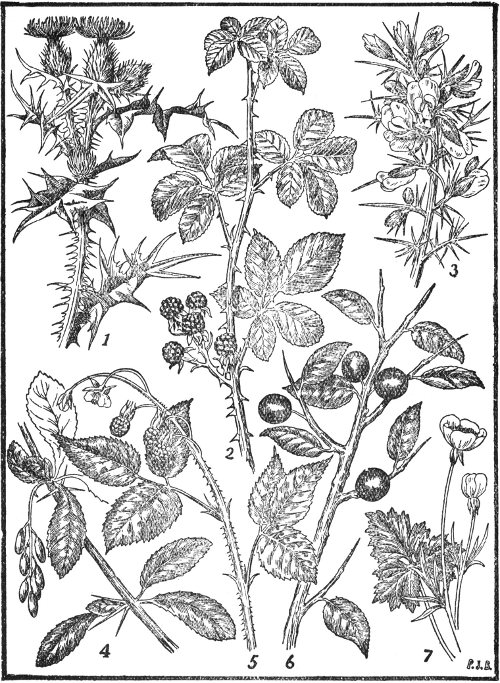
Armed Plants.
“This is the most prickly plant of all,” said Frank, as he halted before a huge thistle. “You can scarcely touch it without getting severely pricked.”
“The thistle is well armed,” said Uncle George. “There are sharp prickles on its leaves, on its stem, and on its flowers.”
As they walked down the road they came upon a mass of whin bushes.
“Here,” said Uncle George, “we have a plant which has turned its leaves into sharp spines.” He bent down and pulled up a tiny plant which was growing under the larger gorse bushes. “Look at this little plant, boys. This is a young whin plant.”
“But it is not a bit like the whin, Uncle George,” said Tom. “Its leaves are soft and flat. They are more like clover leaves. There are no spines or prickles on this little plant.”
“That is so, Tom; but still it is a young whin plant.
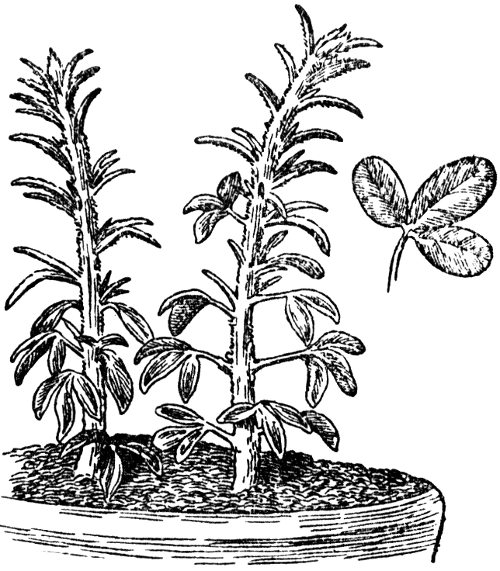
Young Whins.
“There are a great many of these young whins growing under the older bushes. Let us take a few of them home. If we grow one of them in a pot, and supply it with plenty of water, we will find that it will never produce sharp prickles.”
“That is very wonderful,” said Frank.
“It is,” said Uncle George, “and it teaches us something of the whin’s history. Like the nettle, the whin is 56 a juicy plant, and, if it were not for its prickles, would be eaten by cows, sheep, and horses. In fact, some farmers give whins to their horses. Of course the whins are passed through a mill first. The mill crushes the whins and destroys the prickles.
“It shows us that many, many years ago the whin was a soft-leaved plant like the clover. It grew in moist soil. But by and by other plants invaded the land. These plants grew more quickly than the whin, and choked it out of the rich moist soil. Forced to grow upon bare hill-sides and commons, the soft-leaved juicy whin would be destroyed by grazing animals if it did not arm itself with sharp spines.
“Here is the blackthorn or sloe. It bears many hard, sharp-pointed spines. Yet, if we grow a sloe plant in the garden, we find that its sharp spines gradually disappear. They become branches bearing leaves and flowers.
“But plants have other ways of protecting themselves against animals. Look through the hedge into the meadow and you will notice that while the grass has been eaten bare, there are other plants which have been left to grow up untouched. Buttercups grow up all over the field, and tall ragwort plants. How is it that the cows do not eat these plants? They are not armed with spines or prickles.
“They protect themselves in another way. They contain bitter or poisonous juices. No cow will eat a buttercup. If it did so it would be ill and uncomfortable for a time.
“I want you to notice, boys, that—with the exception of those plants, like the bramble and wild rose, which 57 use their prickles for climbing as well as for protection—all our armed plants grow in exposed places. The thistle and whin are good examples of this.”
Frank and Tom returned from the horse pond one day with their jars filled with curious creatures.
“We took the water beetle back to the pond, Uncle George,” said Frank, “and I almost felt sorry to let such a cruel and greedy monster loose among the other creatures in the pond.”
“You have here creatures even more cruel and greedy than the diving beetle,” said his uncle, looking into the glass jars which the boys had brought.
“Here is the larva of the diving beetle, and a fiercer or greedier creature is not to be found in the whole world.”
Uncle George refilled the three large tanks. He poured the contents of one of the jars into one of the tanks. It contained, besides the larvæ he spoke of, a number of tadpoles, some small stickle-backs, and a great many water snails or whelks.
In addition to these, there were one or two curious insects, with a pair of very long legs. They came to the surface every now and then, and moved their long limbs like oars. Whenever the tank was touched, they would suddenly dive to the bottom. Here they would remain for a short time, then, returning to the surface, would “oar” themselves along as usual.
“What are these queer things, Uncle George?” Tom asked. “They look exactly like little boats.”
“They are beetles,” Uncle George replied, “and they 59 do resemble little row-boats—so much so that they are called ‘water boatmen.’ This beetle’s body is shaped like a boat, and he lies on his back and moves his very long hind legs exactly like oars. He has a large, sharp beak, which you can see if you look closely.”
Just as Uncle George was speaking, a small fly alighted on the surface of the water. It was immediately seized by a water boatman, who dived with it to the bottom of the tank.
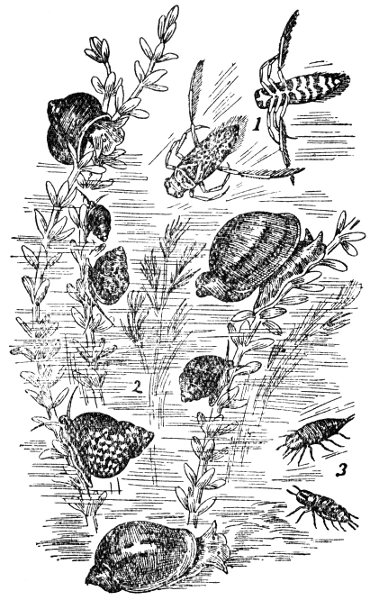
“That is how the creature feeds,” said Uncle George. “When an unlucky fly comes near, he seizes it with his two fore pairs of short legs, drives his cruel beak deep into its body, and dives with it to the bottom of the pool. When he has drowned his victim, he devours it at leisure.
“But let us look at the creature I first spoke of—the larva of the diving beetle.”
There were several in the tank. Uncle George lifted one out with a small gauze net. He placed it in a saucer of water and asked the boys to sketch it.
“It has six legs,” said Frank. “Its head is large and flat, and there are two things like horns sticking out of it.”
“These are the creature’s jaws,” said his uncle.
Uncle George touched the creature’s head with the point of his pencil. Instantly the long, curved fangs moved apart, and the creature sprang at the pencil and closed its fangs upon the wood.
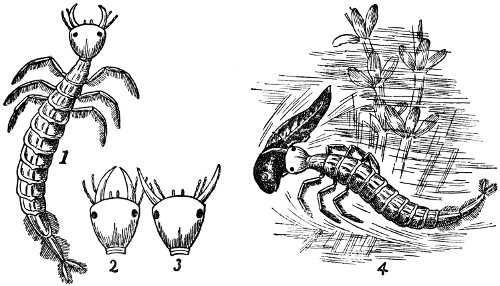
“What a fierce creature,” said Tom.
“Yes,” replied his uncle. “We must remove the others from the tank, or there will be nothing left alive in it. See, one of them has caught a tadpole already.” And, sure enough, the creature had sunk his cruel pincers deep into the body of a tadpole. He shook the tadpole as a dog would shake a rat.
“Those huge fangs are hollow,” Uncle George continued. “With them he sucks every drop of blood from 61 his victim’s body. In this way he devours tadpoles, whelks, little fishes, and even his own weaker brethren.
“We shall have to put these larvæ in a tank by themselves, and feed them upon pieces of fresh raw meat, to keep them from devouring one another.
“Now, boys, I am going to describe this larva. Look closely, and see if I am right. You can correct your drawings as we go along.
“His body, which is nearly two inches long, is narrow at each end and broad at the middle. It is divided into twelve segments, and to each of the first three of these segments a pair of legs are attached. His large, flat head is almost heart-shaped. At its broad end are a pair of large, beady eyes, three pairs of organs which look like feelers, and the two large, curved fangs with which he seizes his prey.
“Notice how beautifully the legs are adapted for swimming. They are edged with long, stiff hairs, which stand out flat with every down stroke, but fold in when the legs move upwards. That is how the creature is such a graceful swimmer.
“The last three segments of his body are thickly covered with long hairs. His tail is divided into two long plumes. You can see what these are for, I hope.”
“Oh yes,” said Frank. “Like the parent beetle, the larva comes often to the surface and hangs downwards with his tail exposed to the air. So these plumes must be his breathing organs.”
“And do these long, slender creatures actually become broad, stout beetles like the one we returned to the pond to-day?” Tom asked.
“Yes, Tom, they do. Just as your green caterpillar 62 became a beautiful white butterfly. These larvæ hatched out of eggs which were laid by the female beetle in the stem of some water weed. She first cuts a slit in the water weed, and then places an egg in the slit.
“When the larvæ are full grown, they crawl out of the pond and bury themselves in ground. Here they pass the winter in the pupa stage. They come out in spring, fully-formed beetles, and pass the remainder of their lives in the water.”
“What are these curious creatures that crawl among the water weeds?” Frank asked. “They are very like the ‘slaters’ which we find among old wood-work in the garden.”
“That creature is the ‘water hog.’ Its proper name is Asellus, and it is very closely related to the garden ‘slater’ or wood-louse.
“These water hogs, like the whelks, are very useful in an aquarium. They eat up all waste matter, and so help greatly to keep the water fresh.
“By the by, I want you to watch the whelks from day to day. They usually lay their eggs in a clear, broad band on the inside of the glass tank; and with our lenses we can watch the changes in these eggs nicely.”
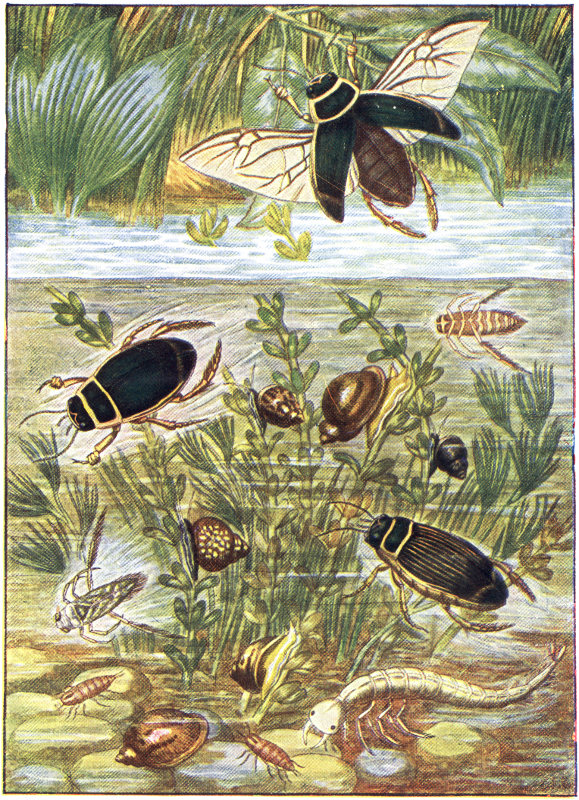
The wasp’s nest was found at the edge of the wood, hanging from the branch of a small tree. It was greyish white in colour, shaped like a pear, and about the size of a hen’s egg.

Uncle George removed it from the branch and carried it home carefully, for it was very light and very fragile. He took a pair of scissors and cut through the thin walls so as to remove nearly half of the coverings. When he had finished cutting, two thin, papery shells fell upon the table, one a size smaller than the other.
“Examine the stuff the wasp’s nest is made of, and tell me what it is most like, boys,” he said.
“It is more like paper than anything else,” said Tom.
“It is paper,” said his uncle.
“Where did the wasps find this paper?” Frank asked.
“Not ‘wasps,’ Frank, but wasp,” his uncle answered, “for this nest was all built by one wasp. The insect did 64 not find the paper. She made it. It was the wasp who first taught man to make paper.
“The queen wasp awakens from her winter sleep in spring, and at once sets about making her nest. She gathers tiny fragments of wood and bark, chews them up, and mixes them with a fluid from her mouth. This, when it hardens, is paper.
“First she makes a stiff rod, or pillar, of paper. This hangs down from the branch and forms the centre of the nest. Round this are built the walls of her house.
“Observe, boys, that there are two distinct walls of paper, one inside the other; and there is a wide air space between them all the way round. The entrance to the nest is at the bottom. Round the centre pillar there is a little thing shaped like an opened umbrella. If you look underneath this, you will see something curious, I think.”
“Oh,” said Frank, “it is divided into six cells, and in each cell there is a small, stout maggot or grub. I can see them moving.”
“These are the young wasps,” said Uncle George. “Like your butterflies and caddis flies, the wasp passes through egg, larva (or caterpillar), and pupa stage before it becomes a perfect insect. These are in the larva stage but, unlike your caterpillars, they have no legs, and they cannot feed themselves.”
“Then the mother wasp must have laid an egg in each cell,” said Frank, “and these grubs hatched out of them.”
“That is so,” said Uncle George. “You see what a clever and industrious creature a wasp is. To build this beautiful nest all alone and unaided, and to rear and feed her helpless grubs, is a task indeed.”
“What are the wasp grubs fed on?” asked Frank.
“At first,” said Uncle George, “they are fed on animal food, and this keeps the queen wasp hunting insects all day long. As they grow older, they are fed upon honey.
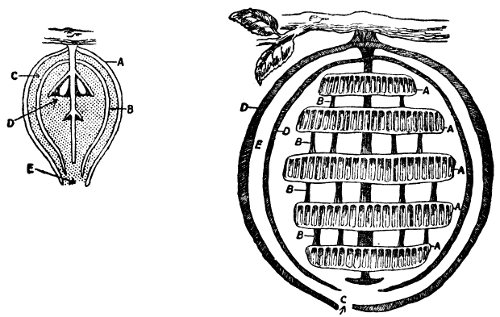
“The wasps which come from these first eggs are ‘worker’ wasps. As soon as they are hatched out, they begin to enlarge the nest. This they do by removing the inside wall and building a new and larger outer wall. This is done from time to time, until at last the nest becomes as big as an ordinary-sized turnip. While this is going on, more and more cells are being built inside, until at last five or six large combs of cells fill the inside of the nest. The queen wasp lays an egg in each cell as it is formed; and the worker wasps gather food and nurse the young grubs until they become perfect wasps.
“By and by some young queens, or female wasps, are 66 hatched out. These lay eggs, and soon the population the paper nest numbers many thousands.”
“And that is why the gardener kills every wasp he sees in spring time,” said Frank.
“Every wasp we see in spring,” said Uncle George, “is a queen wasp. If allowed to live, each queen would become the founder of a nest and the mother of thousands of wasps.”
“But why destroy the wasps?” asked Tom.
“Because wasps are very destructive and dangerous insects,” said Uncle George. “They destroy our best fruit, and their sting is poisonous, sometimes causing death.”
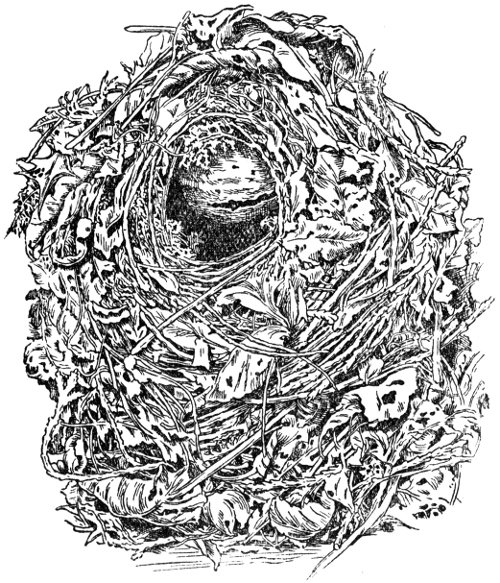
Wasp’s Nest inside Wren’s Nest.
During the summer the boys found several wasp’s nests. One was built under-ground at the roadside. Another was built inside a wren’s nest. The queen wasp who built it had driven the wrens out. A third nest hung from the branch of a gooseberry bush in the garden.
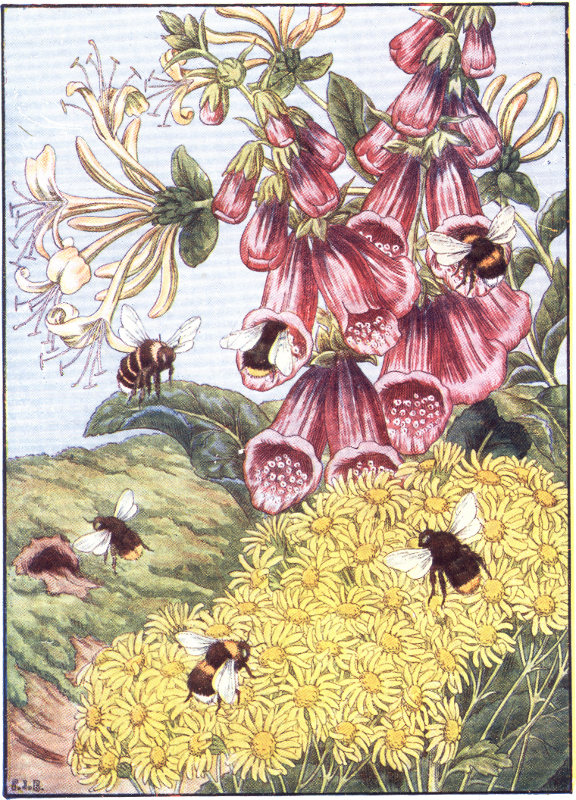
Humble Bees and Nest.
The latter was watched by Uncle George and the boys as it grew larger and larger. Soon, however, the wasps became too numerous. One day they chased Tom and Frank out of the garden and stung them badly. Then Uncle George removed the nest. Putting on his bee-veil and gloves, he cut off the branch from which the nest hung. He put nest and branch inside a large box; and, having placed a saucer containing burning sulphur inside the box, he closed the lid.
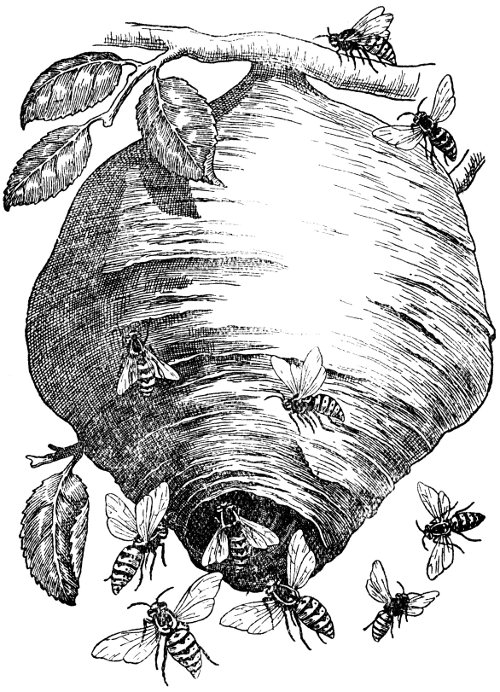
Nest of Tree Wasp.
In the morning the wasps were all dead, and the boys examined the huge nest. Thus they were able to see queens, workers, and male wasps, eggs, larvæ, and pupæ, and to make drawings of each.
“What becomes of the wasps in winter?” Frank asked his uncle.
“They come to a sad end, Frank,” said Uncle George. “They do not store food like the hive bee, and so, when the cold weather comes, they starve to death.
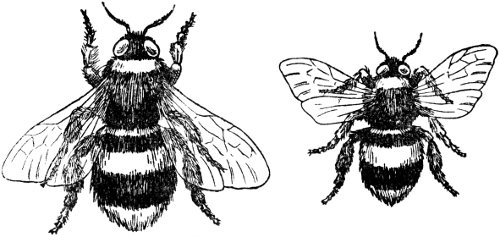
“Our good-humoured and hard-working friend, the humble bee, shares the same fate. A few young queens leave the nest before winter comes on. These bury themselves in mossy banks and sleep the winter through.”
Uncle George and the boys were having a stroll along a lane where briar and hawthorn and all sorts of wild flowers grew. Although it was an October day the sun was shining brightly, and all along the wayside the golden flowers of the dandelion opened wide to the sunlight.
“I thought that the dandelion was an early summer flower,” said Frank.
“So it is,” said his uncle; “but this year the autumn has been so warm that our dandelions are flowering a second time. This often happens with many of our wild flowers during an extra mild season.
“You ought to dig up one of these dandelion plants, take it home and grow it in a pot. It is a most interesting plant to observe, especially the growth and ripening of its seeds. I see here dandelion flowers in almost every stage of their growth.
“If you look you will find among the wide open flower-heads many others which are closed. Let us split a few of these down the centre, and we will find that they are not all alike.
“Here is one with a bright yellow tip. This one has not yet opened. If you use your lens you will notice that, like the daisy, this is not a single flower, but is made up of a great many small yellow florets. These florets stand upon a flat round disc, and they are surrounded by two rings of green things called bracts. One set of these 70 bracts stands up straight. These protect the florets. They open and close the flower. The down pointing bracts protect the flower from ants and crawling insects.
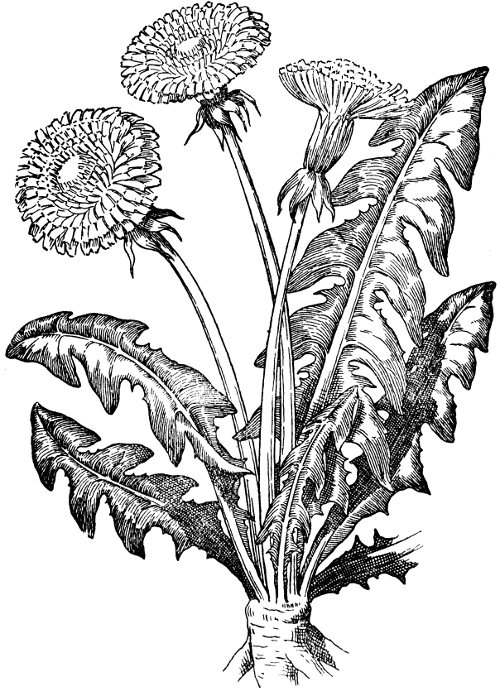
Dandelion.
“Now, Frank, look at the split flower and tell me what you see with your glass.”
“The florets are all of one kind,” said Frank. “They are all strap shaped, and there are a great many of them. The younger florets are in the middle.”
“If you were to pull the florets out and count them you would find about three hundred of them in a single flower-head,” said Uncle George.
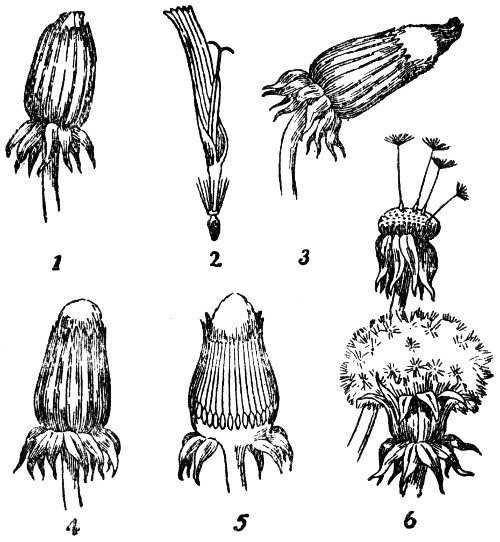
“Now, take one single floret and examine it, please. It is very like the outer (white) florets of the daisy. But it is more complete. There is a large seed-vessel at the bottom. Just above this there are a great number of long silky hairs. You will see what these are for by and by. The lower part of the floret is tubular, but it opens up into a long yellow strap-shaped petal. There are really five petals all joined together here.”
“Oh yes,” said Frank, “at the top of the floret I can see five distinct teeth, and five ridges run down from them. I also see the barrel-shaped ring of stamens.”
“Let us gather some more of the closed flowers,” said Uncle George.
“Here are two other closed flowers. One of them has a yellow tip, withered and faded almost to brown. The other has a white woolly tip.”
“Have these not opened yet?” Tom asked.
“Oh yes! they have opened and closed up again. The dandelion opens out to the sun so that flying insects may visit it and carry pollen from flower to flower. When it has received, in this way, enough pollen to enable its seeds to form, it closes up completely and remains closed until its seeds are ripened. During this time the short stalk between the seed-vessel and petal part grows long. If you look again at a single floret you will see that this short stout stack bears the long straight hairs I spoke of. The flower-head closes so tightly that the yellow strap-shaped petal parts of the florets are squeezed together into a bunch. They soon wither. Meantime all the hair-tipped seed-stalks are growing longer and longer. At last they push the bunch of withered petals right out of the flower and it falls off.”
Uncle George then gathered a few more closed heads, and, by cutting them open, showed the boys all the stages in the growth of the seeds.
“When the dandelion flower-head opens for the last time, instead of a flat golden mass of florets, this is what appears.” As he spoke, Uncle George pointed to a dandelion head which was one huge fluffy ball of stalked seeds.
Frank held it up and blew his breath upon it. Immediately all the seeds went sailing through the air.
“Why does the flower-head keep closed when the seeds are ripening?” asked Tom.
“Because,” answered Uncle George, “not only has the seed to ripen, but a plumed stalk has to be formed by means of which the seed is carried away from the parent plant. These plumes have to be perfectly dry or they would be of no use as sails to the seed. Notice that it is only on dry days that these ‘clocks’ of the dandelion appear.”
“But, Uncle George,” said Frank, “are these seeds actually fitted with feathery tops so that they may be carried far away from the parent plant?”
“Certainly, my boy. You would not have them all trying to grow in the place where the parent plant grows, would you? There would be no room for three hundred seeds to grow there. Besides that, the parent plant has already exhausted the soil. It is necessary that they should seek pastures new, and therefore the seeds of most plants are furnished with some means of travelling.”
“Are all seeds carried by the wind?” Tom asked.
“Oh dear no,” Uncle George replied, “plants have many ways of scattering their seeds. Some plants, by suddenly bursting their seed-vessels, shoot their seeds far out; some seeds are furnished with little hooks which grip on to the fur of passing animals; some are carried by birds; but by far the greater number are scattered by the wind.
“We shall learn more about these at some future time. Meantime we will grow a dandelion plant at 74 home, and watch the opening and closing of its flowers, and the wonderful way in which its travelling seeds are produced.”

TROUT
One day in November the postman brought Uncle George a small wooden box. There were holes bored in the sides and top of it. The box, when opened, seemed to be filled with damp moss; but when some of this moss was removed there was found in the middle of the box a piece of folded muslin.
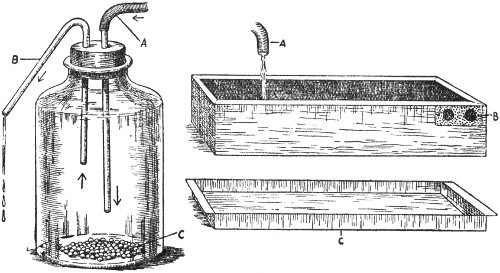
Uncle George laid the muslin on the table, and opened it out. It contained a number of tiny pink balls, much smaller than peas.
“These are the trout eggs you promised to get for us, are they not?” said Frank.
“They are,” said Uncle George, “and we must put 76 them into running water at once. I have a bottle here ready for them.”
Uncle George filled a wide-mouthed bottle with water from the tap and placed the eggs in it. He then corked it with a cork in which he had bored two holes.
Into each of the holes he had fitted a tube. One tube was long enough to reach almost to the bottom of the bottle. The other was bent over the outside of the bottle.
The straight tube was connected with the water tap by a piece of indiarubber tubing. He then turned the tap on gently, so that the water went in by the straight tube and came dripping out by the bent tube.
“Trout require a constant supply of fresh water,” he said. “Their eggs are usually laid in shallow streams.
“Now, boys, I want you to watch these eggs and note down any changes you see in them. You can remove the bottle from the tap at any time, but you must not keep it more than fifteen minutes at a time, or your trout will not hatch.”
At the end of a week the boys noticed two black dots and a coiled white line in each egg.
In two weeks more some curious-looking creatures were seen wriggling about among the eggs. As there were some empty egg-skins to be seen, they guessed that these lively creatures must be young trout.
They were not a bit like fish. Each seemed to be made up of a long white streak, which looked like the “backbone” of a fish, a big, clumsy yellow bag with red veins running through it, and two large black spots that looked like eyes.
In a few days all the eggs hatched out, and in place of the little pink eggs there was a crowd of these wriggling creatures and a number of empty egg-skins. The boys were puzzled, and Uncle George had to be consulted.
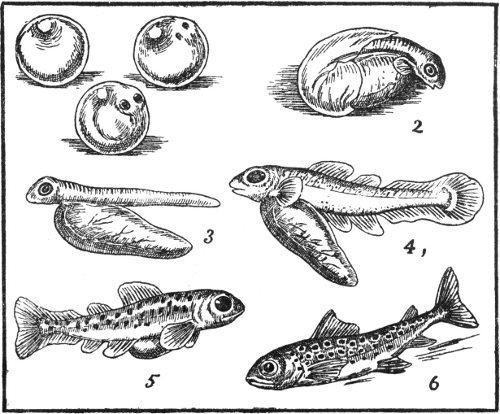
Six Stages in Development of Trout.
“I don’t think these were trout eggs,” said Frank. “The creatures that came out of them are not a bit like fishes. They swim on their sides and have a huge yellow bag attached to their bodies.”
“They are young trout, I can assure you, Frank,” said his uncle laughing. “If you remember, your tadpoles were not a bit like frogs when they hatched out of the egg. These huge bags you talk of are called ‘yolks.’ Each trout when hatched is furnished with a huge yolk or food supply.
“The tadpole, when hatched, has also got a yolk upon which he lives without eating for four or five days. Our trout will require no food for six weeks. During that time the yolk will become smaller and smaller, and at last disappear entirely. While the yolk is shrinking, you will notice that the creature gradually assumes the form of a fish.”
Uncle George emptied the bottle containing the young trout into a wooden box which he had made. This box was fifteen inches long, four inches broad, and four inches deep. The inside of it he had charred with a red-hot iron after it was put together. It was placed under the tap, and the water dripped into it all day and all night.
Frank made a small gauze net about the size of a dessert-spoon, and with this they lifted troutlets out of the box whenever they wanted to examine them.
As their uncle had said, the creatures changed from day to day. By placing a single trout in a white saucer, the boys could note these changes; but they were such lively little creatures that making good sketches of them was somewhat difficult.
First the big black dots became more like eyes. Then delicate fins and tail appeared, and mouths which opened and shut. At the top of the yolk-sac, just under the head, the boys could see a little red thing like a heart beating constantly. As the yolk-sac grew smaller, the little fish’s body grew more shapely, and tiny brown spots appeared all over it.
At last, at the end of six weeks, the yolk was completely gone, and the young trout were now beautiful little fish, shaped and coloured exactly like big trout.
Then Uncle George began to feed them. They were fed four times a day on the yolk of an egg which had been boiled for half an hour. A very small quantity of this hard yolk was squeezed through a piece of gauze into the water, and the little fishes dashed at it and gobbled it up greedily.
They were so rapid in their movements, swimming about and leaping out of the water, that the boys were never tired of watching them.
“What are the brown spots on a trout for?” Frank asked his uncle one day.
“The trout is protected by his colour,” said Uncle George. “Each trout is coloured like the bed of the stream he lives in, and the spots resemble grains of sand and tiny pebbles. The trout can change his colour, like the frog, as I will show you.”
Uncle George took two trout out of the box and placed them in a glass dish. He placed the dish in a white saucer, and so arranged it that water was kept flowing into and out of it.
Next day he took two more trout out of the box and placed them in the glass dish. It was then seen that the first two trout had grown quite light in colour. They were much paler than those taken out of the box, the inside of which was charred and black.
One day Uncle George found two of the trout dead in the box.
“I am afraid, boys,” he said, “that we cannot keep them confined any longer. Get a large pail full of water, and we will carry them to the brook.”
“We must come here and fish next year, Frank,” said Tom, after the trout were transferred to the brook. 80 “How long will it be before they become big trout, Uncle George?”
“They are now about an inch long,” said Uncle George. “In a year they will be four inches long. In about three years, if they are not devoured by larger trout, they will weigh about a pound apiece.”
“I think it is a shame to kill such pretty little creatures,” said Frank.
“I quite agree with you, Frank,” said his uncle.
The silkworm eggs came in a very small box. They were sent by a friend of Uncle George’s who lived in the south of England. The eggs were stuck to pieces of paper in scattered groups. Some pieces of paper had only one or two eggs on them, others had as many as forty. They were small, round things, flattened on the top, and coloured light green. They reminded the boys of small mustard seeds, but they were not so round.
In answer to Frank’s question as to why the eggs were laid in irregular groups, Uncle George answered:
“When the silk-moth emerges from her pupa case, she lays her eggs anywhere on the floor of her cage. As the eggs are coated with a gluey material when newly laid, they stick firmly to the floor.
“Those people who rear silkworms always have a sheet of clean paper covering the floor of the cage before egg-laying commences. After the eggs are laid, they are found adhering to this sheet of paper. The paper is taken out of the larva cage, and those parts containing eggs are cut out with scissors.”
“How many eggs are laid by one moth,” Frank asked.
“From four to five hundred,” his uncle replied. “Let us get our larva cage cleaned out, and we will put these eggs in the lower part of it and await their hatching.”
“Why in the lower part,” Frank asked, as he set about cleaning the cage.
“Because its floor is a drawer which can be pulled out. If you put them in the upper part, you must lay a sheet of paper on the floor first, for your silkworms must not be handled on any account.”
“And how long do we have to wait for these eggs to hatch?” asked Tom.
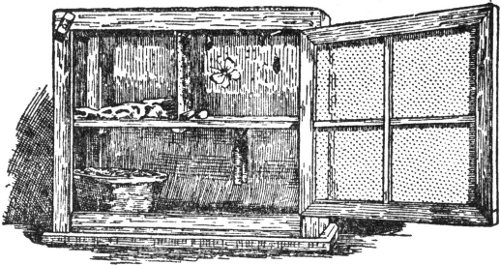
Larva Case.
“That depends altogether upon the amount of warmth they receive, Tom. They will remain unhatched ever so long if kept in a cool place; but whenever they are placed where they can get the necessary amount of warmth, they begin to hatch. Let us put them in the front window, where they can get most sunshine.”
About a week after the larva cage was placed in the window, Frank reported to his uncle that some of the eggs had turned white.
“Take your lens and examine carefully those eggs which have lost their colour,” said Uncle George.
Lifting out one of the small pieces of paper with eggs on it, Frank examined it with the glass.
“Oh,” he said, “these colourless eggs are just empty shells, and there are two small creatures crawling along the edge of the paper. How small they are! They are no longer than the breadth of a pin-head. They are almost black in colour, covered all over with hair, and have very large heads.”
“Well, these are newly-hatched silkworms,” said Uncle George, “and they are already looking for food. Run out to the garden and bring in some fresh lettuce leaves.”
Uncle George carefully dried the lettuce leaves before putting them into the cage. In two days all the eggs were hatched, and in their place were as many black, hairy, crawling little creatures with clumsy heads. Although they did not seem to eat much, they grew very rapidly. When three days old, they were fully twice as big as when hatched.
In five days the silkworms seemed to have increased in number as well as in size. In fact, there seemed to be twice as many grubs as there were of eggs.
Then Uncle George explained that half of these were not grubs, but simply empty skins.
“The silkworm, in order to grow, must cast its skin,” he said. “It does this four times during its lifetime. Look out for another moult, or skin-casting, in four days’ time.”
Four days later the grubs cast their skins again, just as Uncle George had said. They were now about half an inch in length, and much lighter in colour.
In six further days they moulted a third time. Instead of dingy, hairy grubs, they were now hairless caterpillars, 84 yellowish-white in colour, and with round black heads. Their fourth and last moult took place in another week. By this time they were over an inch in length. They now began to eat the lettuce leaves ravenously, and grew very fast. For ten days they ate much and grew rapidly. Then they seemed to get tired of feeding, and began to crawl lazily up the sides of their cage.
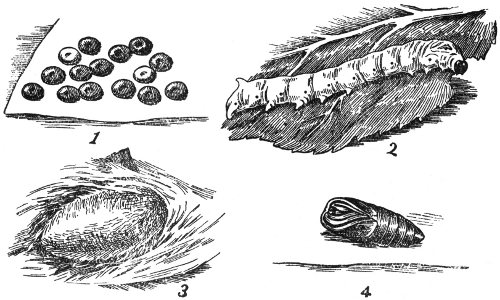
Silk Moth.
“They are full grown now, boys,” said Uncle George, “and will soon begin to spin their silken cocoons.
“They are now about three inches long, and very different from the tiny hairy grubs which came out of the eggs over a month ago.”
“We have been comparing drawings of them with drawings we made of the caterpillar of the white cabbage 85 butterfly,” said Frank, “and we find that they are very much alike.”
“That is good,” said Uncle George. “They are, indeed, very much alike. The body is made up of thirteen segments, and they have the same number of legs. They differ from the cabbage caterpillar, however, in size and colour. Notice the little horn which sticks up out of the twelfth segment. Your cabbage caterpillar did not have that. If you look closely you will notice a long silk thread issuing from the head of one of these silk-spinning caterpillars. This one has just begun to make his cocoon; and, in order to prevent his threads becoming entangled with those of the other caterpillars, I will place this small paper cone over him.”
Next day Uncle George covered several of the caterpillars with paper cones. On the roof of the cage the boys saw one caterpillar surrounded with a flimsy web of silk of a golden-yellow colour. As they watched the creature turning its head round and round inside the silky veil, their uncle told them that the creature was spinning silk at the rate of about a foot per minute.
In three days each caterpillar had surrounded itself with a dense silken cocoon as large as a walnut. Then Uncle George took one of the cocoons, and, cutting it open, showed the boys the brown, shining chrysalis inside. He took another cocoon, and, having dipped it into warm water, began to wind the silken thread on to a piece of card.
Both Frank and Tom were amazed at the length of this silken thread. They were more surprised when they 86 were told that each caterpillar produces a silk thread more than half a mile long.
“Tell us, please, Uncle George,” said Frank, “why the creature spins all this silk, and how it makes it?”
“You are asking a difficult question,” said his uncle, “but I will tell you something about it.
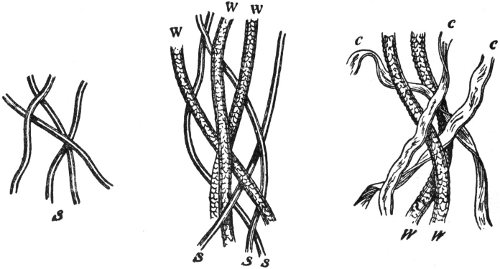
“The creature spins this cocoon to protect its chrysalis, of course. The silk is produced in two long, coiled tubes, which occupy nearly the whole length of the creature’s body.
“Silk, before it issues from the caterpillar’s body, is a fluid. Whenever it comes out into the air, it becomes horny. Two strands are produced at once—one from each of the long coiled tubes. Before they leave the caterpillar’s body they are pressed together to form one flat, ribbon-like thread. Silk is one of the strongest fibres in the world. It is nearly as strong as steel, and much stronger than many of our metals.
“In a fortnight your silken cocoons will produce white, fluffy moths. ‘Then you can supply your friends with hundreds of ‘silkworm’ eggs, and still have enough over to stock your larva cage.”

Silk Moths—Male and Female.
STRUCTURE OF STEMS.—One- and two-year-old twigs of horse-chestnut, elm, and willow should be cut into half-inch lengths and distributed among the class. If cut straight across with a sharp pen-knife, the different layers can be seen with the naked eye. Afterwards these pieces should be slit longitudinally, and the various tissues peeled off by the pupils.
BULBS AND CORMS.—Bulbs of snowdrop and tulip, and corms of crocus, can be bought from seedsmen, from September to January, at from 6d. to 1s. per 100. At any other season of the year the onion will make a good substitute.
WILLOW TWIGS will root readily if placed in water and kept near the hot pipes in school.
VEGETABLE FINGERS.—To illustrate this lesson, peas (of any kind) ought to be grown in school. Branches of the many wild peas and vetches are to be found in abundance in every hedgerow during spring, summer, and autumn. Branches of Virginia creeper, clematis, tropæolum (Indian cress) may be shown with advantage. The compound leaves of the rose, ash, or mountain ash should be shown along with those of sweet-pea and edible pea, and the amount of green (assimilating) area compared.
THE GREAT WATER BEETLE is found in nearly every pond. One or two should be kept and fed upon small worms. These beetles can also be obtained from any naturalist dealer. The larvæ of this beetle is found in ponds in summer months.
“WATER BOATMAN” BEETLES (notonecta and corrixa) are common to all our ponds.
PLANT ARMOUR.—Branches of whin, bramble, hawthorn, and barberry, and leaves of holly, thistle, and nettle will be found to illustrate 89 this lesson. Young whin plants are to be found plentifully in spring, growing under the old bushes. One of these should be grown in a pot in school and kept well watered. It will produce no prickles.
TROUT EGGS are obtainable from any of the fisheries—e.g., Howietoun Fisheries, Stirling, or Solway Fisheries, Dumfries, at about 1s. per 100, from October till April. They are easily hatched and reared wherever running water can be obtained. If not hatched in a bottle, as described in Lesson XIII., the ova ought to be placed in a shallow trough of perforated zinc suspended in a small wooden box. The inside of the box must be charred with a red-hot iron to prevent fungal growths. When the yolk-sac is completely absorbed, the young trout should be fed on yolk of hard-boiled egg, and, later on, on a mixture of this and chopped raw beef. In each case the food should be squeezed through perforated zinc.
“SILKWORMS.”—Eggs of the silk-bearing moth (Bombex Mori) can be had from Messrs Watkins & Doncaster, 36 Strand, London, and other dealers, at 4d. and 6d. per 100. The larva should be fed on mulberry or lettuce leaves, and the leaves should never be given wet.
Caterpillars of Tiger Moth (Arctia caja), Emperor Moth (Saturnia carpini), or Puss Moth (Cerura vinula) should be kept for comparison.
PRINTED IN GREAT BRITAIN BY THOMAS NELSON AND SONS, LTD.
The following List gives a rough idea of the main Contents in each Volume of this Series:—
End of the Project Gutenberg EBook of The 'Look About You' Nature Study
Books, Book 4 (of 7), by Thomas W. Hoare
*** END OF THIS PROJECT GUTENBERG EBOOK NATURE STUDY BOOKS, BOOK 4 ***
***** This file should be named 50347-h.htm or 50347-h.zip *****
This and all associated files of various formats will be found in:
http://www.gutenberg.org/5/0/3/4/50347/
Produced by Juliet Sutherland, Stephen Hutcheson, and the
Online Distributed Proofreading Team at http://www.pgdp.net
Updated editions will replace the previous one--the old editions will
be renamed.
Creating the works from print editions not protected by U.S. copyright
law means that no one owns a United States copyright in these works,
so the Foundation (and you!) can copy and distribute it in the United
States without permission and without paying copyright
royalties. Special rules, set forth in the General Terms of Use part
of this license, apply to copying and distributing Project
Gutenberg-tm electronic works to protect the PROJECT GUTENBERG-tm
concept and trademark. Project Gutenberg is a registered trademark,
and may not be used if you charge for the eBooks, unless you receive
specific permission. If you do not charge anything for copies of this
eBook, complying with the rules is very easy. You may use this eBook
for nearly any purpose such as creation of derivative works, reports,
performances and research. They may be modified and printed and given
away--you may do practically ANYTHING in the United States with eBooks
not protected by U.S. copyright law. Redistribution is subject to the
trademark license, especially commercial redistribution.
START: FULL LICENSE
THE FULL PROJECT GUTENBERG LICENSE
PLEASE READ THIS BEFORE YOU DISTRIBUTE OR USE THIS WORK
To protect the Project Gutenberg-tm mission of promoting the free
distribution of electronic works, by using or distributing this work
(or any other work associated in any way with the phrase "Project
Gutenberg"), you agree to comply with all the terms of the Full
Project Gutenberg-tm License available with this file or online at
www.gutenberg.org/license.
Section 1. General Terms of Use and Redistributing Project
Gutenberg-tm electronic works
1.A. By reading or using any part of this Project Gutenberg-tm
electronic work, you indicate that you have read, understand, agree to
and accept all the terms of this license and intellectual property
(trademark/copyright) agreement. If you do not agree to abide by all
the terms of this agreement, you must cease using and return or
destroy all copies of Project Gutenberg-tm electronic works in your
possession. If you paid a fee for obtaining a copy of or access to a
Project Gutenberg-tm electronic work and you do not agree to be bound
by the terms of this agreement, you may obtain a refund from the
person or entity to whom you paid the fee as set forth in paragraph
1.E.8.
1.B. "Project Gutenberg" is a registered trademark. It may only be
used on or associated in any way with an electronic work by people who
agree to be bound by the terms of this agreement. There are a few
things that you can do with most Project Gutenberg-tm electronic works
even without complying with the full terms of this agreement. See
paragraph 1.C below. There are a lot of things you can do with Project
Gutenberg-tm electronic works if you follow the terms of this
agreement and help preserve free future access to Project Gutenberg-tm
electronic works. See paragraph 1.E below.
1.C. The Project Gutenberg Literary Archive Foundation ("the
Foundation" or PGLAF), owns a compilation copyright in the collection
of Project Gutenberg-tm electronic works. Nearly all the individual
works in the collection are in the public domain in the United
States. If an individual work is unprotected by copyright law in the
United States and you are located in the United States, we do not
claim a right to prevent you from copying, distributing, performing,
displaying or creating derivative works based on the work as long as
all references to Project Gutenberg are removed. Of course, we hope
that you will support the Project Gutenberg-tm mission of promoting
free access to electronic works by freely sharing Project Gutenberg-tm
works in compliance with the terms of this agreement for keeping the
Project Gutenberg-tm name associated with the work. You can easily
comply with the terms of this agreement by keeping this work in the
same format with its attached full Project Gutenberg-tm License when
you share it without charge with others.
1.D. The copyright laws of the place where you are located also govern
what you can do with this work. Copyright laws in most countries are
in a constant state of change. If you are outside the United States,
check the laws of your country in addition to the terms of this
agreement before downloading, copying, displaying, performing,
distributing or creating derivative works based on this work or any
other Project Gutenberg-tm work. The Foundation makes no
representations concerning the copyright status of any work in any
country outside the United States.
1.E. Unless you have removed all references to Project Gutenberg:
1.E.1. The following sentence, with active links to, or other
immediate access to, the full Project Gutenberg-tm License must appear
prominently whenever any copy of a Project Gutenberg-tm work (any work
on which the phrase "Project Gutenberg" appears, or with which the
phrase "Project Gutenberg" is associated) is accessed, displayed,
performed, viewed, copied or distributed:
This eBook is for the use of anyone anywhere in the United States and
most other parts of the world at no cost and with almost no
restrictions whatsoever. You may copy it, give it away or re-use it
under the terms of the Project Gutenberg License included with this
eBook or online at www.gutenberg.org. If you are not located in the
United States, you'll have to check the laws of the country where you
are located before using this ebook.
1.E.2. If an individual Project Gutenberg-tm electronic work is
derived from texts not protected by U.S. copyright law (does not
contain a notice indicating that it is posted with permission of the
copyright holder), the work can be copied and distributed to anyone in
the United States without paying any fees or charges. If you are
redistributing or providing access to a work with the phrase "Project
Gutenberg" associated with or appearing on the work, you must comply
either with the requirements of paragraphs 1.E.1 through 1.E.7 or
obtain permission for the use of the work and the Project Gutenberg-tm
trademark as set forth in paragraphs 1.E.8 or 1.E.9.
1.E.3. If an individual Project Gutenberg-tm electronic work is posted
with the permission of the copyright holder, your use and distribution
must comply with both paragraphs 1.E.1 through 1.E.7 and any
additional terms imposed by the copyright holder. Additional terms
will be linked to the Project Gutenberg-tm License for all works
posted with the permission of the copyright holder found at the
beginning of this work.
1.E.4. Do not unlink or detach or remove the full Project Gutenberg-tm
License terms from this work, or any files containing a part of this
work or any other work associated with Project Gutenberg-tm.
1.E.5. Do not copy, display, perform, distribute or redistribute this
electronic work, or any part of this electronic work, without
prominently displaying the sentence set forth in paragraph 1.E.1 with
active links or immediate access to the full terms of the Project
Gutenberg-tm License.
1.E.6. You may convert to and distribute this work in any binary,
compressed, marked up, nonproprietary or proprietary form, including
any word processing or hypertext form. However, if you provide access
to or distribute copies of a Project Gutenberg-tm work in a format
other than "Plain Vanilla ASCII" or other format used in the official
version posted on the official Project Gutenberg-tm web site
(www.gutenberg.org), you must, at no additional cost, fee or expense
to the user, provide a copy, a means of exporting a copy, or a means
of obtaining a copy upon request, of the work in its original "Plain
Vanilla ASCII" or other form. Any alternate format must include the
full Project Gutenberg-tm License as specified in paragraph 1.E.1.
1.E.7. Do not charge a fee for access to, viewing, displaying,
performing, copying or distributing any Project Gutenberg-tm works
unless you comply with paragraph 1.E.8 or 1.E.9.
1.E.8. You may charge a reasonable fee for copies of or providing
access to or distributing Project Gutenberg-tm electronic works
provided that
* You pay a royalty fee of 20% of the gross profits you derive from
the use of Project Gutenberg-tm works calculated using the method
you already use to calculate your applicable taxes. The fee is owed
to the owner of the Project Gutenberg-tm trademark, but he has
agreed to donate royalties under this paragraph to the Project
Gutenberg Literary Archive Foundation. Royalty payments must be paid
within 60 days following each date on which you prepare (or are
legally required to prepare) your periodic tax returns. Royalty
payments should be clearly marked as such and sent to the Project
Gutenberg Literary Archive Foundation at the address specified in
Section 4, "Information about donations to the Project Gutenberg
Literary Archive Foundation."
* You provide a full refund of any money paid by a user who notifies
you in writing (or by e-mail) within 30 days of receipt that s/he
does not agree to the terms of the full Project Gutenberg-tm
License. You must require such a user to return or destroy all
copies of the works possessed in a physical medium and discontinue
all use of and all access to other copies of Project Gutenberg-tm
works.
* You provide, in accordance with paragraph 1.F.3, a full refund of
any money paid for a work or a replacement copy, if a defect in the
electronic work is discovered and reported to you within 90 days of
receipt of the work.
* You comply with all other terms of this agreement for free
distribution of Project Gutenberg-tm works.
1.E.9. If you wish to charge a fee or distribute a Project
Gutenberg-tm electronic work or group of works on different terms than
are set forth in this agreement, you must obtain permission in writing
from both the Project Gutenberg Literary Archive Foundation and The
Project Gutenberg Trademark LLC, the owner of the Project Gutenberg-tm
trademark. Contact the Foundation as set forth in Section 3 below.
1.F.
1.F.1. Project Gutenberg volunteers and employees expend considerable
effort to identify, do copyright research on, transcribe and proofread
works not protected by U.S. copyright law in creating the Project
Gutenberg-tm collection. Despite these efforts, Project Gutenberg-tm
electronic works, and the medium on which they may be stored, may
contain "Defects," such as, but not limited to, incomplete, inaccurate
or corrupt data, transcription errors, a copyright or other
intellectual property infringement, a defective or damaged disk or
other medium, a computer virus, or computer codes that damage or
cannot be read by your equipment.
1.F.2. LIMITED WARRANTY, DISCLAIMER OF DAMAGES - Except for the "Right
of Replacement or Refund" described in paragraph 1.F.3, the Project
Gutenberg Literary Archive Foundation, the owner of the Project
Gutenberg-tm trademark, and any other party distributing a Project
Gutenberg-tm electronic work under this agreement, disclaim all
liability to you for damages, costs and expenses, including legal
fees. YOU AGREE THAT YOU HAVE NO REMEDIES FOR NEGLIGENCE, STRICT
LIABILITY, BREACH OF WARRANTY OR BREACH OF CONTRACT EXCEPT THOSE
PROVIDED IN PARAGRAPH 1.F.3. YOU AGREE THAT THE FOUNDATION, THE
TRADEMARK OWNER, AND ANY DISTRIBUTOR UNDER THIS AGREEMENT WILL NOT BE
LIABLE TO YOU FOR ACTUAL, DIRECT, INDIRECT, CONSEQUENTIAL, PUNITIVE OR
INCIDENTAL DAMAGES EVEN IF YOU GIVE NOTICE OF THE POSSIBILITY OF SUCH
DAMAGE.
1.F.3. LIMITED RIGHT OF REPLACEMENT OR REFUND - If you discover a
defect in this electronic work within 90 days of receiving it, you can
receive a refund of the money (if any) you paid for it by sending a
written explanation to the person you received the work from. If you
received the work on a physical medium, you must return the medium
with your written explanation. The person or entity that provided you
with the defective work may elect to provide a replacement copy in
lieu of a refund. If you received the work electronically, the person
or entity providing it to you may choose to give you a second
opportunity to receive the work electronically in lieu of a refund. If
the second copy is also defective, you may demand a refund in writing
without further opportunities to fix the problem.
1.F.4. Except for the limited right of replacement or refund set forth
in paragraph 1.F.3, this work is provided to you 'AS-IS', WITH NO
OTHER WARRANTIES OF ANY KIND, EXPRESS OR IMPLIED, INCLUDING BUT NOT
LIMITED TO WARRANTIES OF MERCHANTABILITY OR FITNESS FOR ANY PURPOSE.
1.F.5. Some states do not allow disclaimers of certain implied
warranties or the exclusion or limitation of certain types of
damages. If any disclaimer or limitation set forth in this agreement
violates the law of the state applicable to this agreement, the
agreement shall be interpreted to make the maximum disclaimer or
limitation permitted by the applicable state law. The invalidity or
unenforceability of any provision of this agreement shall not void the
remaining provisions.
1.F.6. INDEMNITY - You agree to indemnify and hold the Foundation, the
trademark owner, any agent or employee of the Foundation, anyone
providing copies of Project Gutenberg-tm electronic works in
accordance with this agreement, and any volunteers associated with the
production, promotion and distribution of Project Gutenberg-tm
electronic works, harmless from all liability, costs and expenses,
including legal fees, that arise directly or indirectly from any of
the following which you do or cause to occur: (a) distribution of this
or any Project Gutenberg-tm work, (b) alteration, modification, or
additions or deletions to any Project Gutenberg-tm work, and (c) any
Defect you cause.
Section 2. Information about the Mission of Project Gutenberg-tm
Project Gutenberg-tm is synonymous with the free distribution of
electronic works in formats readable by the widest variety of
computers including obsolete, old, middle-aged and new computers. It
exists because of the efforts of hundreds of volunteers and donations
from people in all walks of life.
Volunteers and financial support to provide volunteers with the
assistance they need are critical to reaching Project Gutenberg-tm's
goals and ensuring that the Project Gutenberg-tm collection will
remain freely available for generations to come. In 2001, the Project
Gutenberg Literary Archive Foundation was created to provide a secure
and permanent future for Project Gutenberg-tm and future
generations. To learn more about the Project Gutenberg Literary
Archive Foundation and how your efforts and donations can help, see
Sections 3 and 4 and the Foundation information page at
www.gutenberg.org
Section 3. Information about the Project Gutenberg Literary Archive Foundation
The Project Gutenberg Literary Archive Foundation is a non profit
501(c)(3) educational corporation organized under the laws of the
state of Mississippi and granted tax exempt status by the Internal
Revenue Service. The Foundation's EIN or federal tax identification
number is 64-6221541. Contributions to the Project Gutenberg Literary
Archive Foundation are tax deductible to the full extent permitted by
U.S. federal laws and your state's laws.
The Foundation's principal office is in Fairbanks, Alaska, with the
mailing address: PO Box 750175, Fairbanks, AK 99775, but its
volunteers and employees are scattered throughout numerous
locations. Its business office is located at 809 North 1500 West, Salt
Lake City, UT 84116, (801) 596-1887. Email contact links and up to
date contact information can be found at the Foundation's web site and
official page at www.gutenberg.org/contact
For additional contact information:
Dr. Gregory B. Newby
Chief Executive and Director
[email protected]
Section 4. Information about Donations to the Project Gutenberg
Literary Archive Foundation
Project Gutenberg-tm depends upon and cannot survive without wide
spread public support and donations to carry out its mission of
increasing the number of public domain and licensed works that can be
freely distributed in machine readable form accessible by the widest
array of equipment including outdated equipment. Many small donations
($1 to $5,000) are particularly important to maintaining tax exempt
status with the IRS.
The Foundation is committed to complying with the laws regulating
charities and charitable donations in all 50 states of the United
States. Compliance requirements are not uniform and it takes a
considerable effort, much paperwork and many fees to meet and keep up
with these requirements. We do not solicit donations in locations
where we have not received written confirmation of compliance. To SEND
DONATIONS or determine the status of compliance for any particular
state visit www.gutenberg.org/donate
While we cannot and do not solicit contributions from states where we
have not met the solicitation requirements, we know of no prohibition
against accepting unsolicited donations from donors in such states who
approach us with offers to donate.
International donations are gratefully accepted, but we cannot make
any statements concerning tax treatment of donations received from
outside the United States. U.S. laws alone swamp our small staff.
Please check the Project Gutenberg Web pages for current donation
methods and addresses. Donations are accepted in a number of other
ways including checks, online payments and credit card donations. To
donate, please visit: www.gutenberg.org/donate
Section 5. General Information About Project Gutenberg-tm electronic works.
Professor Michael S. Hart was the originator of the Project
Gutenberg-tm concept of a library of electronic works that could be
freely shared with anyone. For forty years, he produced and
distributed Project Gutenberg-tm eBooks with only a loose network of
volunteer support.
Project Gutenberg-tm eBooks are often created from several printed
editions, all of which are confirmed as not protected by copyright in
the U.S. unless a copyright notice is included. Thus, we do not
necessarily keep eBooks in compliance with any particular paper
edition.
Most people start at our Web site which has the main PG search
facility: www.gutenberg.org
This Web site includes information about Project Gutenberg-tm,
including how to make donations to the Project Gutenberg Literary
Archive Foundation, how to help produce our new eBooks, and how to
subscribe to our email newsletter to hear about new eBooks.